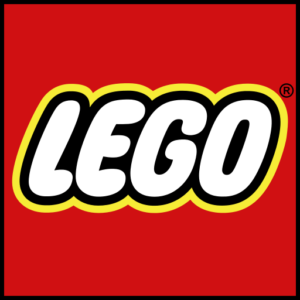Review: LEGO 21355 The Evolution of STEM

21355 The Evolution of STEM is the next LEGO Ideas set coming on 1 March 2025, and true to its name is a celebration of all things Science, Technology, Engineering and Math, paying tribute to the many discoveries and scientists that have shaped the understanding of our modern world.
It’s a really enjoyable set, filled with educational knowledge and history and the big drawcard will be the 3 minifigures included – Marie Skłodowska-Curie, George Washington Carver and Sir Isaac Newton, three pioneers and icons of Science.
The set originated as Knowledge is Power, by fan designer Daniel Bradley in the Celebrate the Wonder of STEM challenge, a collaboration with US retail giant Target, where it’ll be sold. It will also be available from LEGO.com
21355 The Evolution of STEM will be released on 1 March 2025, and will be available from LEGO.com or your local LEGO Store.
See below for pricing and product pages:
- 21355 The Evolution of STEM [US] – US$79.99
- 21355 The Evolution of STEM [AUS] – AU$129.99
- 21355 The Evolution of STEM [UK] – £69.99
- 21355 The Evolution of STEM [EU] – €79.99
- 21355 The Evolution of STEM [CA] – CAD$99.99
Special thanks to LEGO for sending this set over for review. If you’re planning on purchasing or pre-ordering this set, please consider using the affiliate links in this post. I may earn a small commission with each purchase that helps support the work I do on the blog!
21355 The Evolution of STEM Set Details
21355 The Evolution of STEM
21355
The Evolution of STEM
3
879
US$79.99 / AU$129.99 / £69.99 / €79.99 / CAD$99.99
1 January 2025
Ollie Gregory (@concorers), Graphics by Nathan Davis (@obvian)
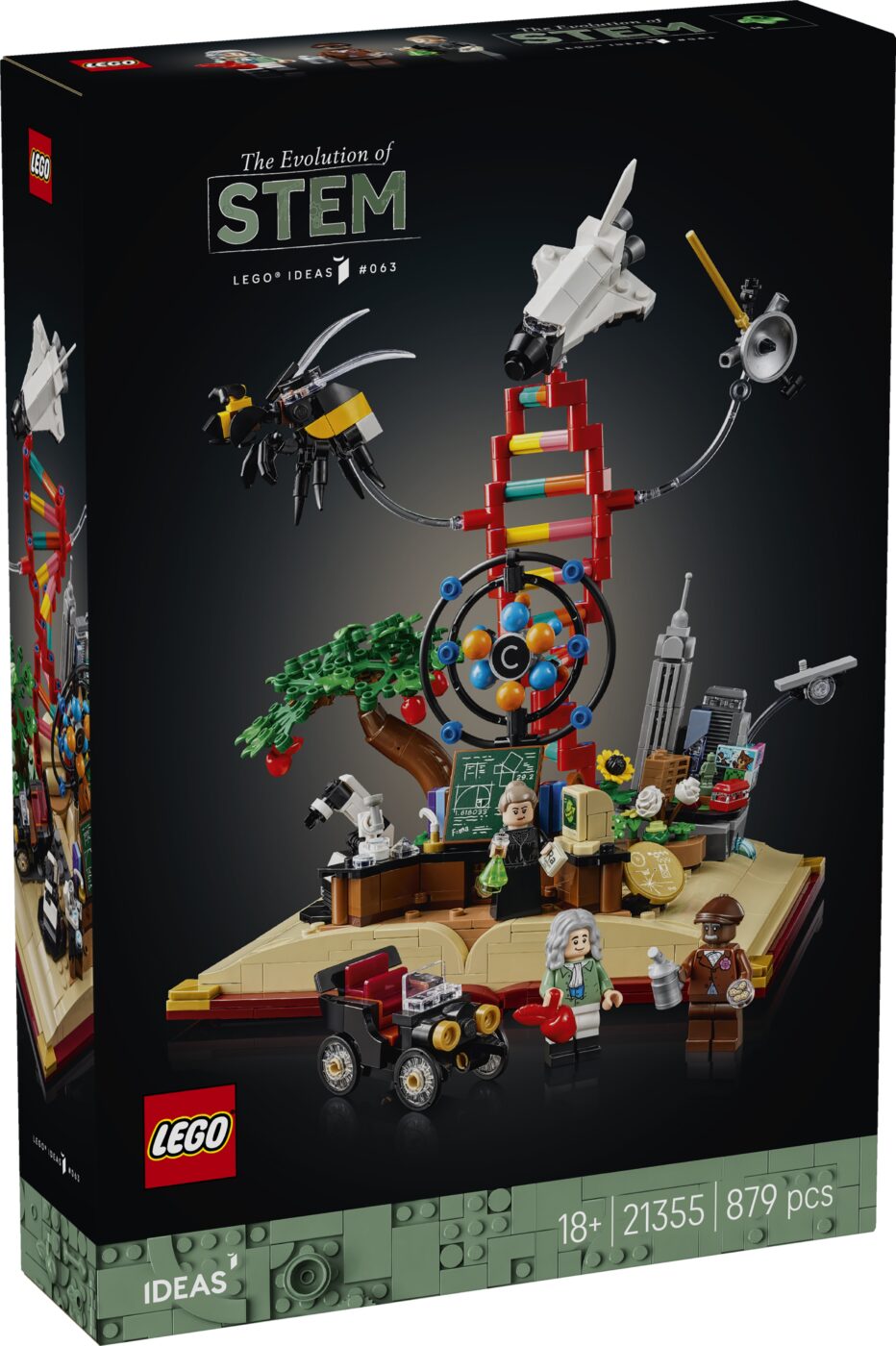

A small sticker sheet is included in the set, which is fairly typical but contains plenty of fun Easter Eggs that graphic designer snuck into the set, with a few dedicated to the fan designer.
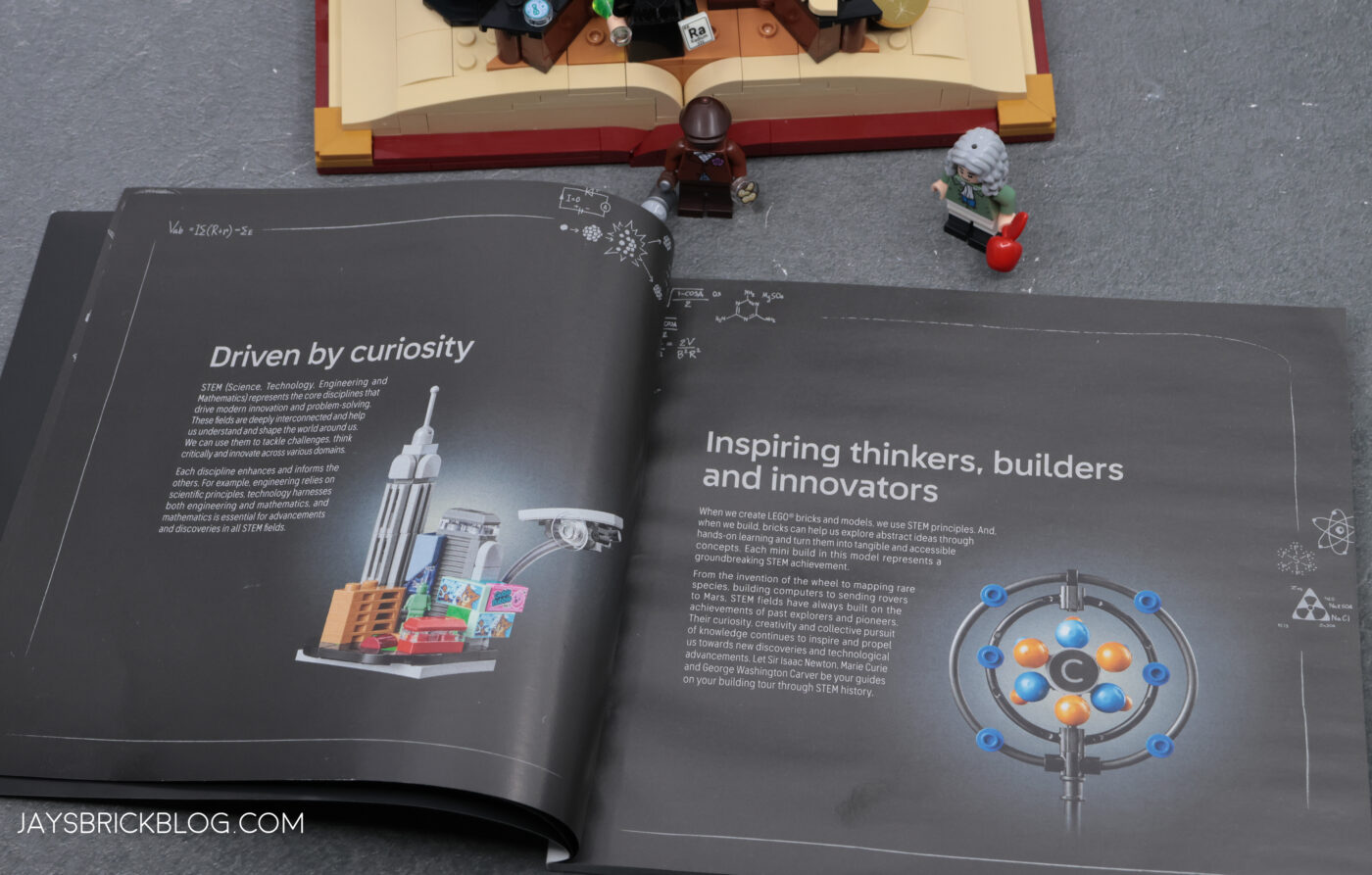
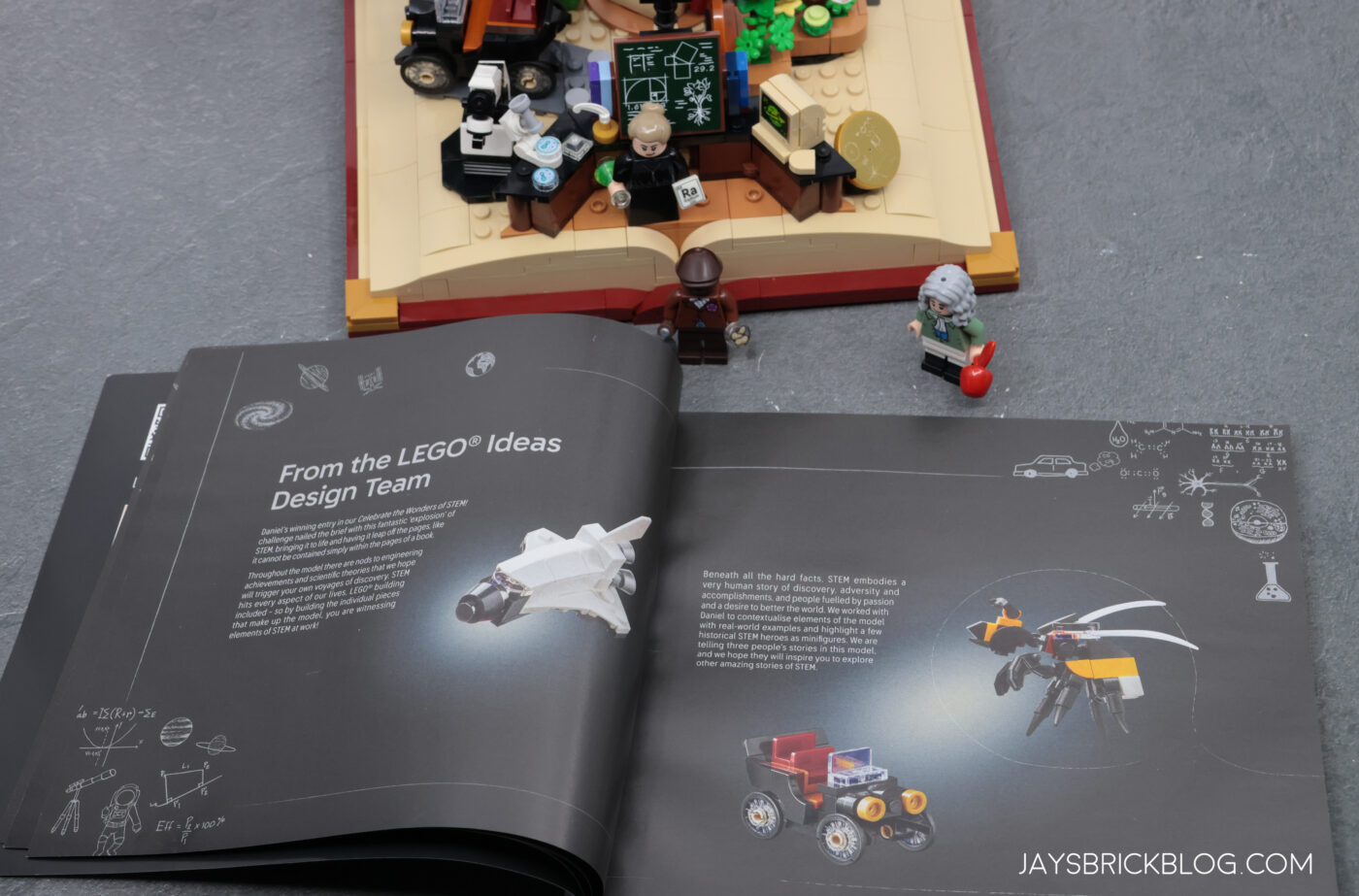
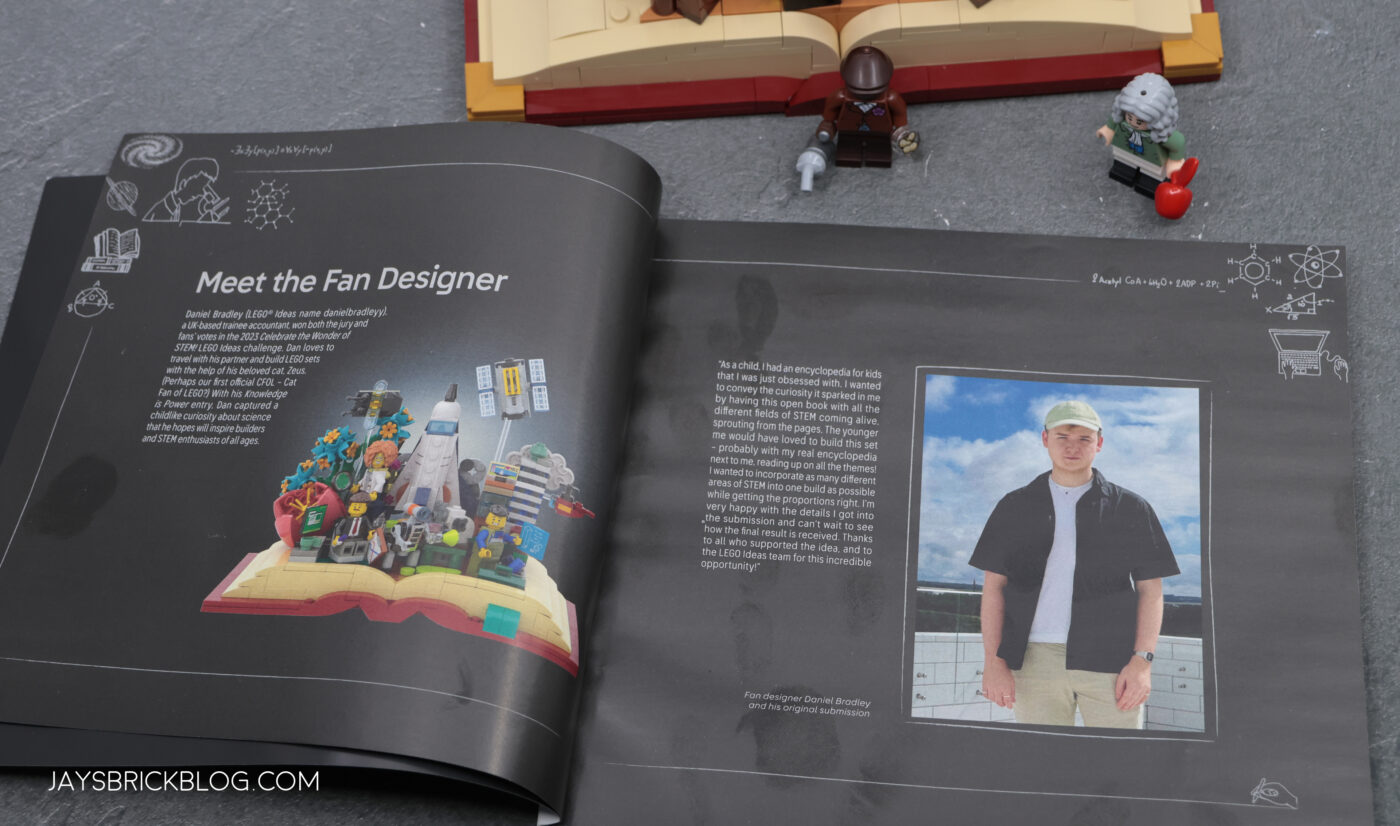
Here’s a look at the instructions manual, which also has a lovely section about the fan designer, Daniel Bradley, and a shot of his original design which won the STEM challenge.

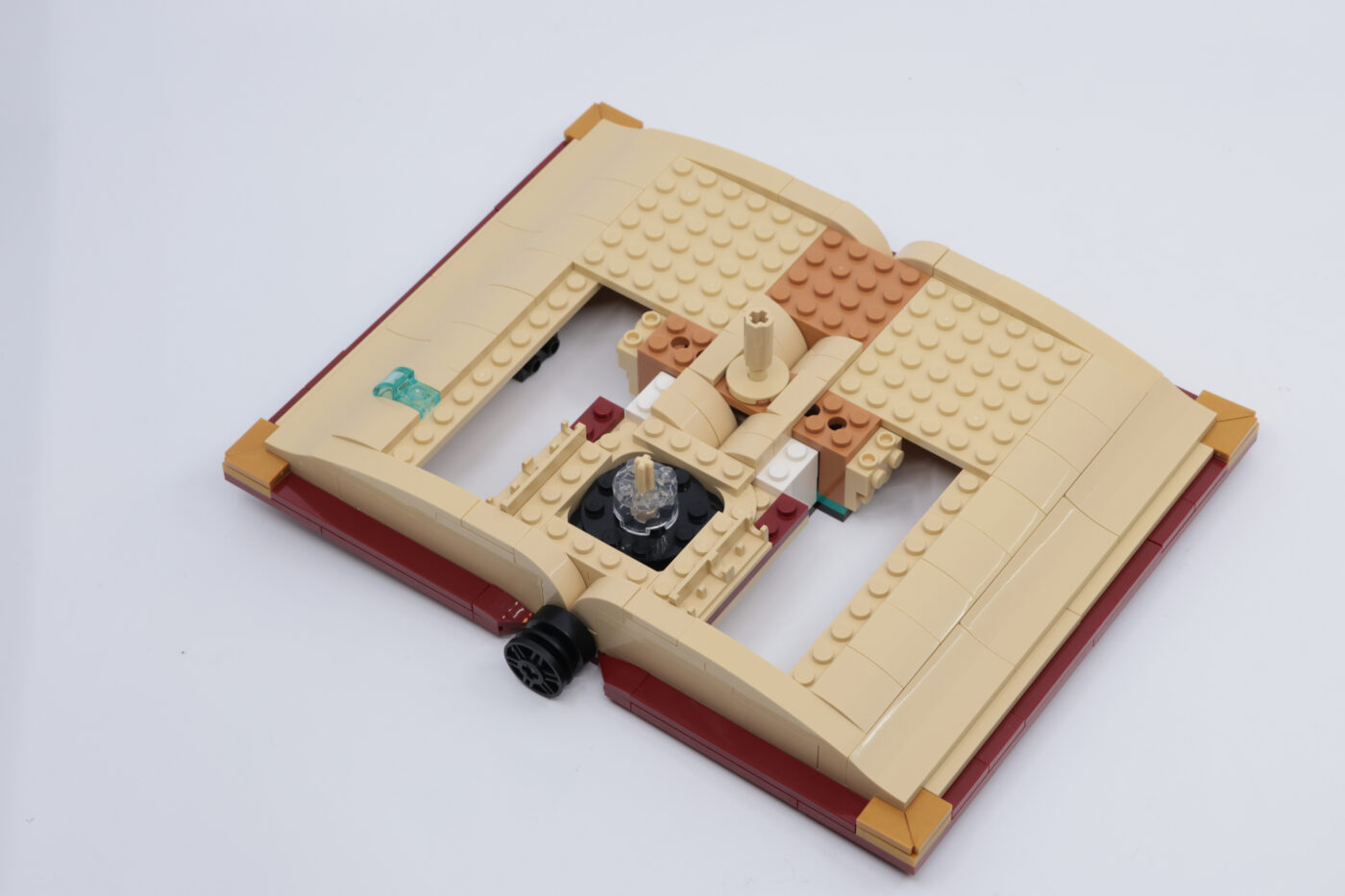


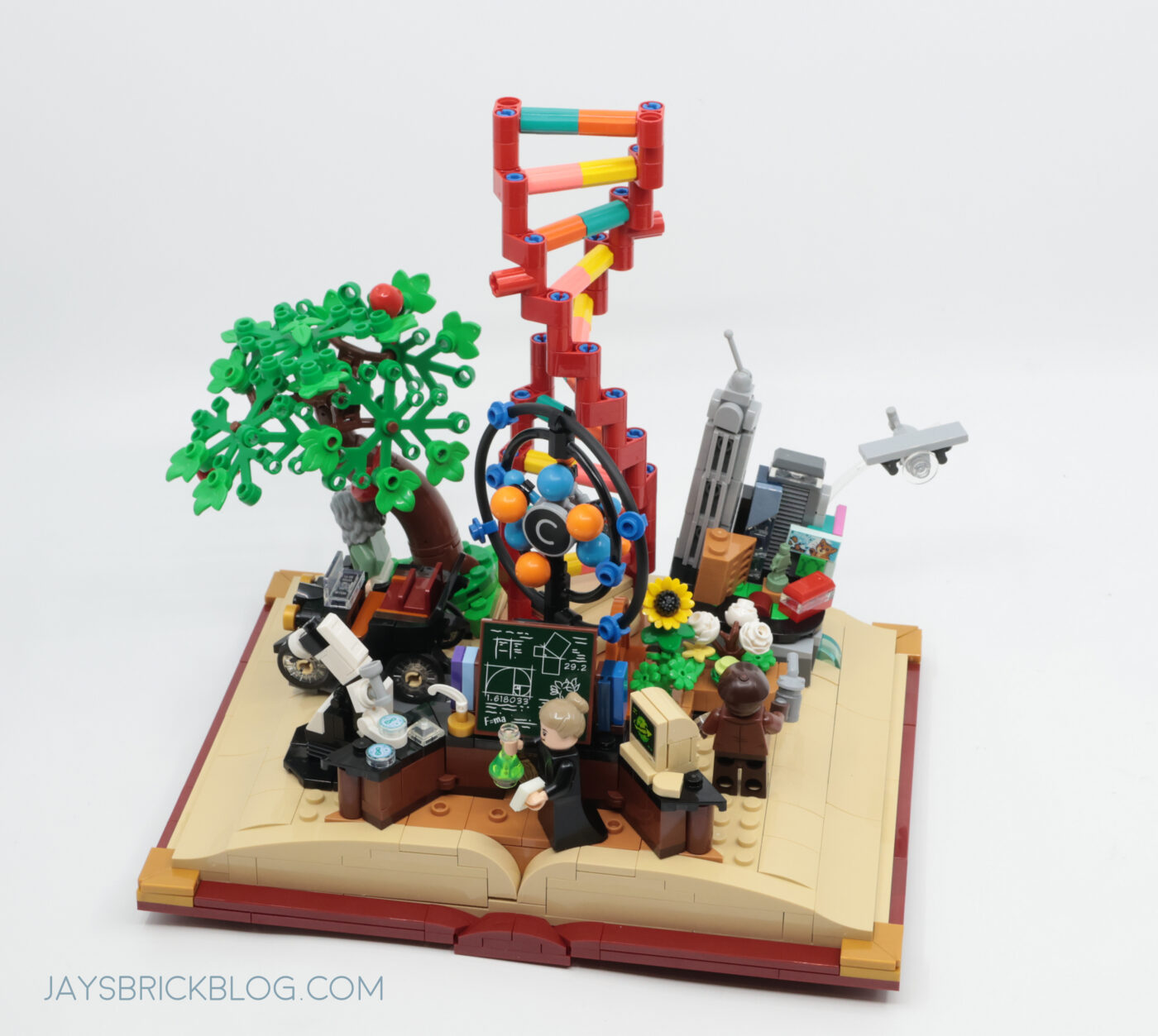
At 879 pieces, it’s not a big build at all, and is something you can comfortably knock out in a few hours, but there’s a lot to love about the build experience. The pop-out book with builds erupting from it is not a particularly novel or innovative design (see recent 40690 Tribute to Jules Verne’s Books GWP), but the density of builds, colours and composition make this a fairly attractive model that won’t take up too much space.
The build is kept interesting throughout, and there are plenty of interesting factoids in the instruction manual. I highly recommend putting on documentaries of Marie Curie, Isaac Newton and George Washington Carver in the background to learn more about these titans of science. Here’s ones I watched during my build.
- How the Genius of Marie Curie Killed Her
- The Secret Side of Sir Isaac Newton
- George Washington Carver: An Uncommon Life
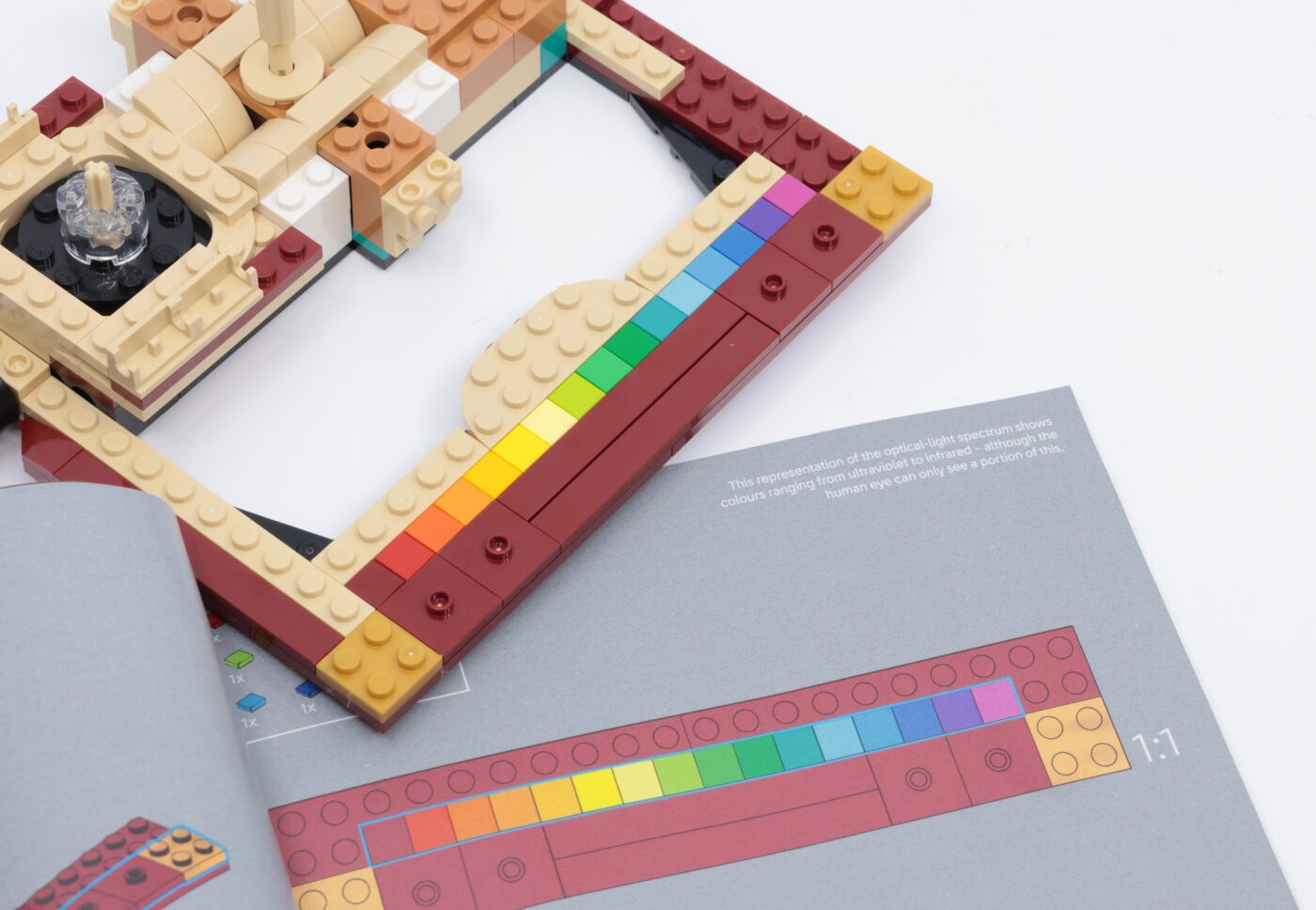
The set is PACKED with Easter Eggs specifically aimed at science enthusiasts, and there are 2 in particular that you encounter that are hidden within the build, such as this optical-light spectrum, which coincidentally was a discovery made by Isaac Newtown, challenging the prevailing thought that colour was primarily white, and tinted by darkness.

On the other edge of the book, there is a Morse Code Easter Egg, which uses white tiles and pill tiles as dots and dashes, paying tribute to Samuel Morse who revolutionised radiotelegraphy and communication.
For those that can’t read morse, the message encoded here are the letters S-T-E-M.
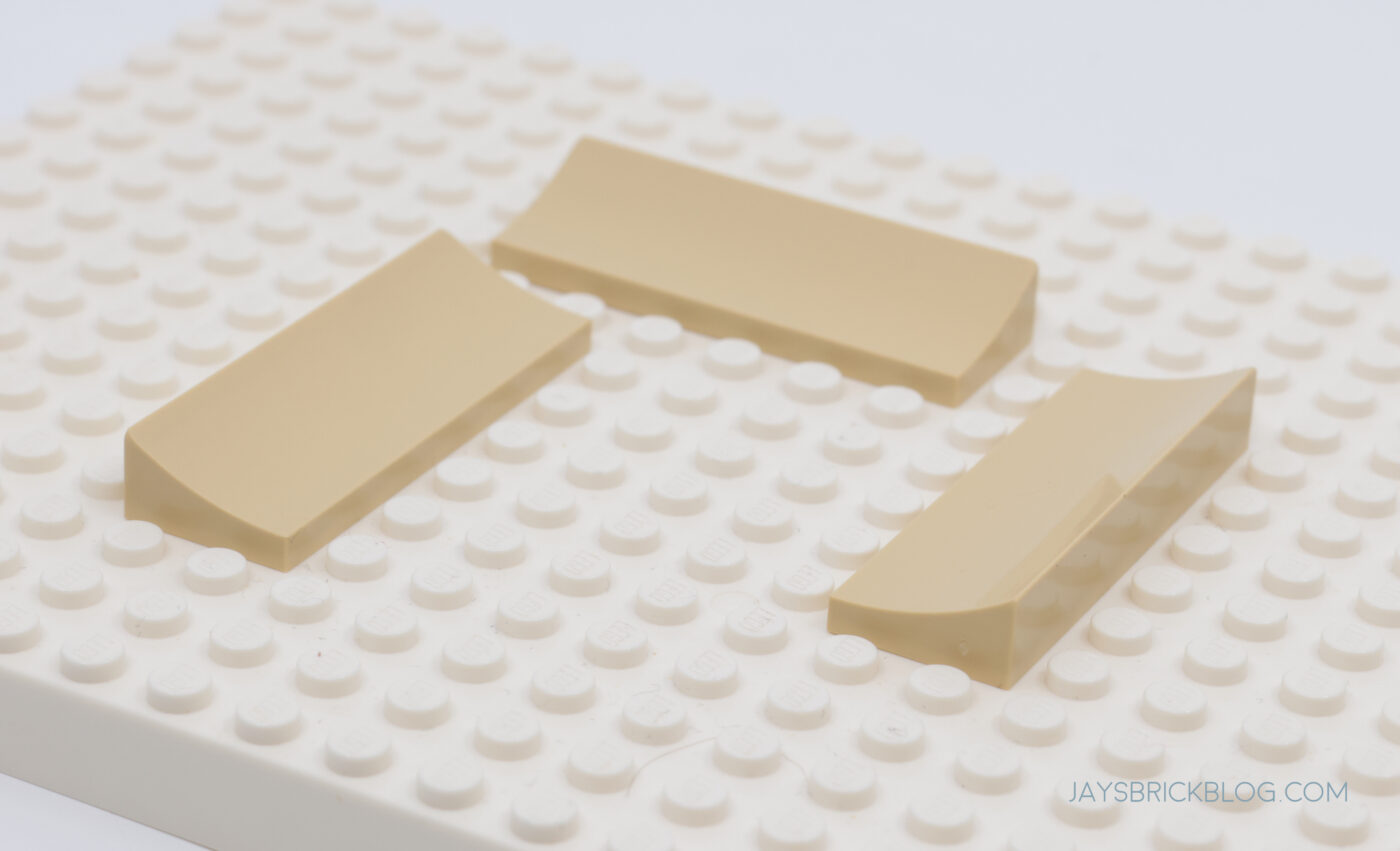
There are a couple of interesting new elements in the set, chiefly this 6-wide inverted slope! It has a very gentle curvature, and is primarily used for the edges of the pages. I kinda like the symbolism that LEGO fans who pick this set up will discover a new element!

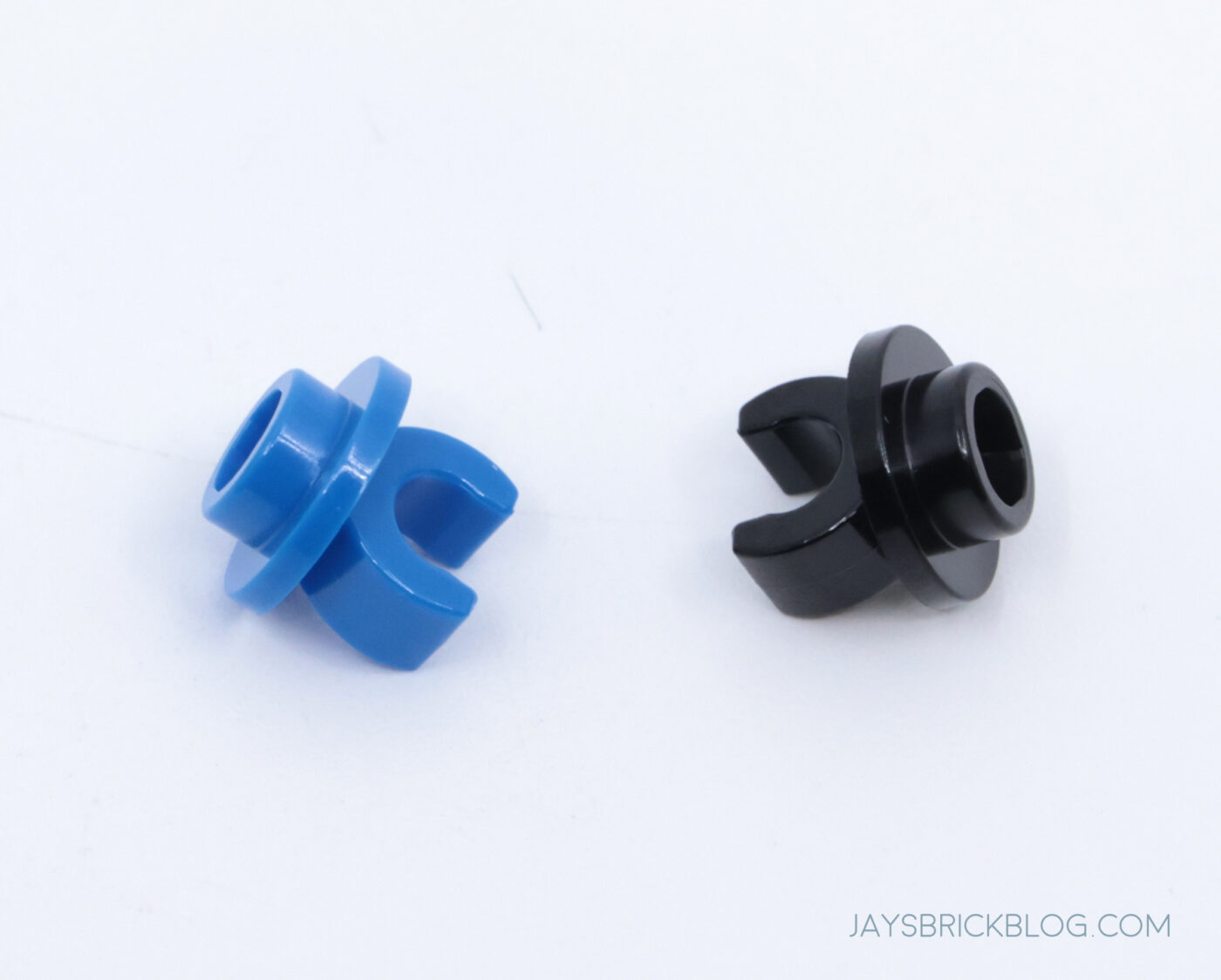
There are also some interesting recolours, such as this teal Axle Connector, and a stud with underside clip which appears in blue for the first time! There is also one immensely cool new printed tile (two, actually), that you’ll see later on in the Minifigures section, and later in the build.
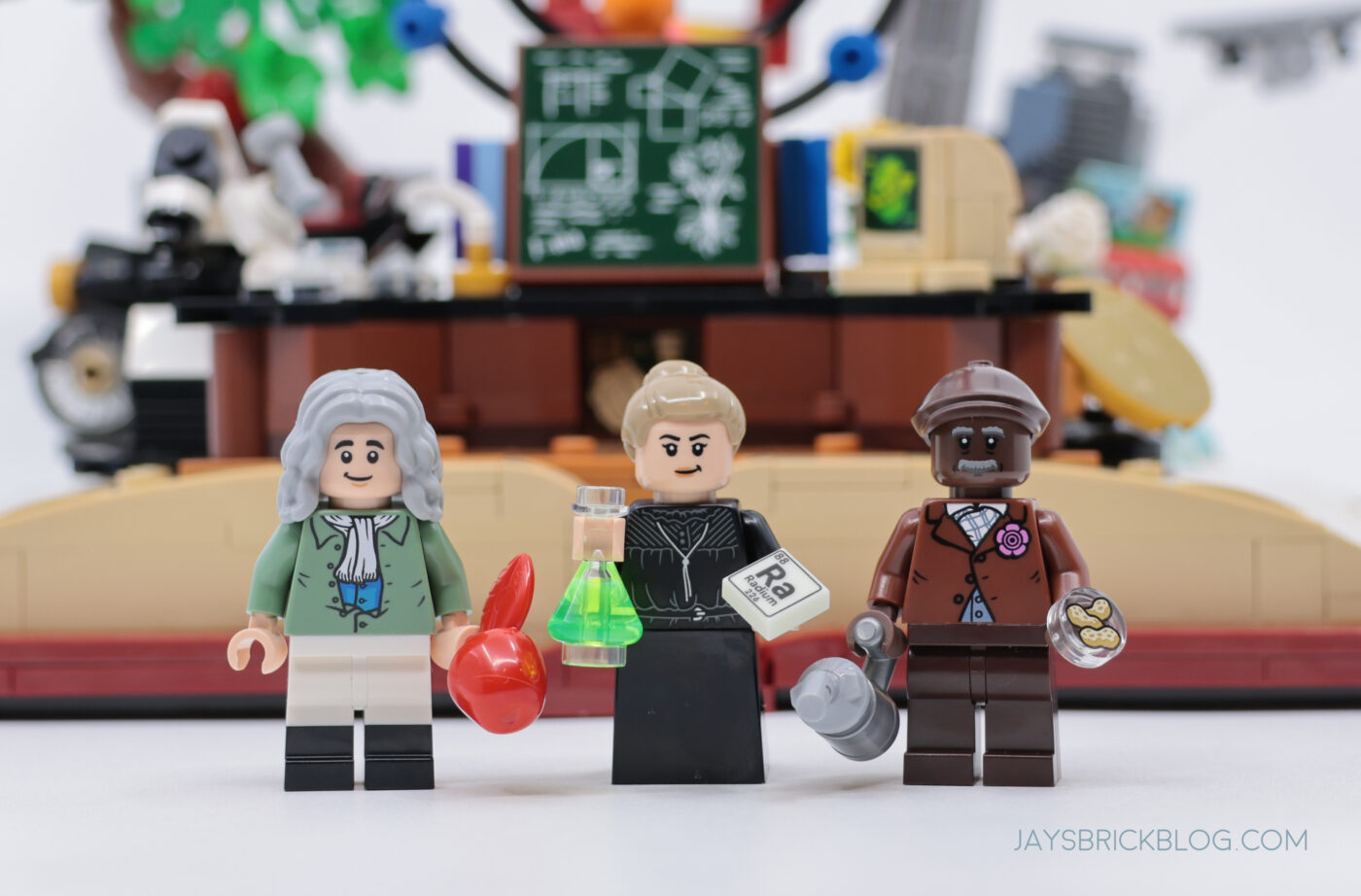
The set comes with three historical minifigures, Sir Isaac Newton, Marie Skłodowska-Curie, and George Washington Carver. Sir Isaac Newton and Marie Curie need no introduction, but non-American LEGO fans might not be as familiar with George Washington Carver, who is an icon and legendary American agricultural scientist and chemist, but I think it’s a great opportunity to learn something new. I certainly did.
George Washington Carver’s inclusion is clearly aimed at the American market (remember, this was a Target collaboration), so I’m sure they wanted a pioneering scientist, and a black slave-turned agricultural scientist that had to overcome slavery in the Deep South would seem to be a good pick.

Sir Isaac Newton is one of the most brilliant scientific minds, responsible for his seminal work Principia, which gave us Newton’s laws of motion and his law of universal gravitation, and also the invention of calculus (regular math, just wasn’t cutting it to explain gravity), among other things, but he’s mostly known in pop culture for figuring out gravity, thanks to the folk legend of an apple falling on his head.
The Isaac Newton Minifigure uses the same head as James Sirius Potter from 76405 Hogwarts Express – Collectors’ Edition or Max Dennison from Hocus Pocus, but his long grey wig does make him somewhat recognisable. I think the jacket and scarf looks a tad too modern for a 17th century man, but it’s somewhat close to some of his portraits where he does rock a white scarf.

Here’s his alternate face, which has an alarmed expression – the face you make when you figure out gravity, no doubt!

Next up we have George Washington Carver. I must admit that I wasn’t familiar at all with GWC prior to this set being announced, but I took it as a learning opportunity and can see why he was included in the set.
He’s a famous American agriculturist and chemist, most notable for overcoming slavery, and a post Civil-War America that was still grappling with segregation and other awful things, to rise up to become the first black student at Iowa State University, before teaching at one of the most important black colleges, Tuskegee University, and is best known for coming up with a myriad of uses for peanuts and sweet potatoes, as well as introducing innovative farming techniques like crop rotation, and steered farmers away from relying solely on cotton.
His minifigure looks fantastic, and it’s quite rare to get an elderly African American man as a minifigure (plus brown hands!), and I love the detail on his brown suit jacket, which has a flower lapel pin, which is a nod to his style and affinity for agriculture.

Here’s a look at his back printing.
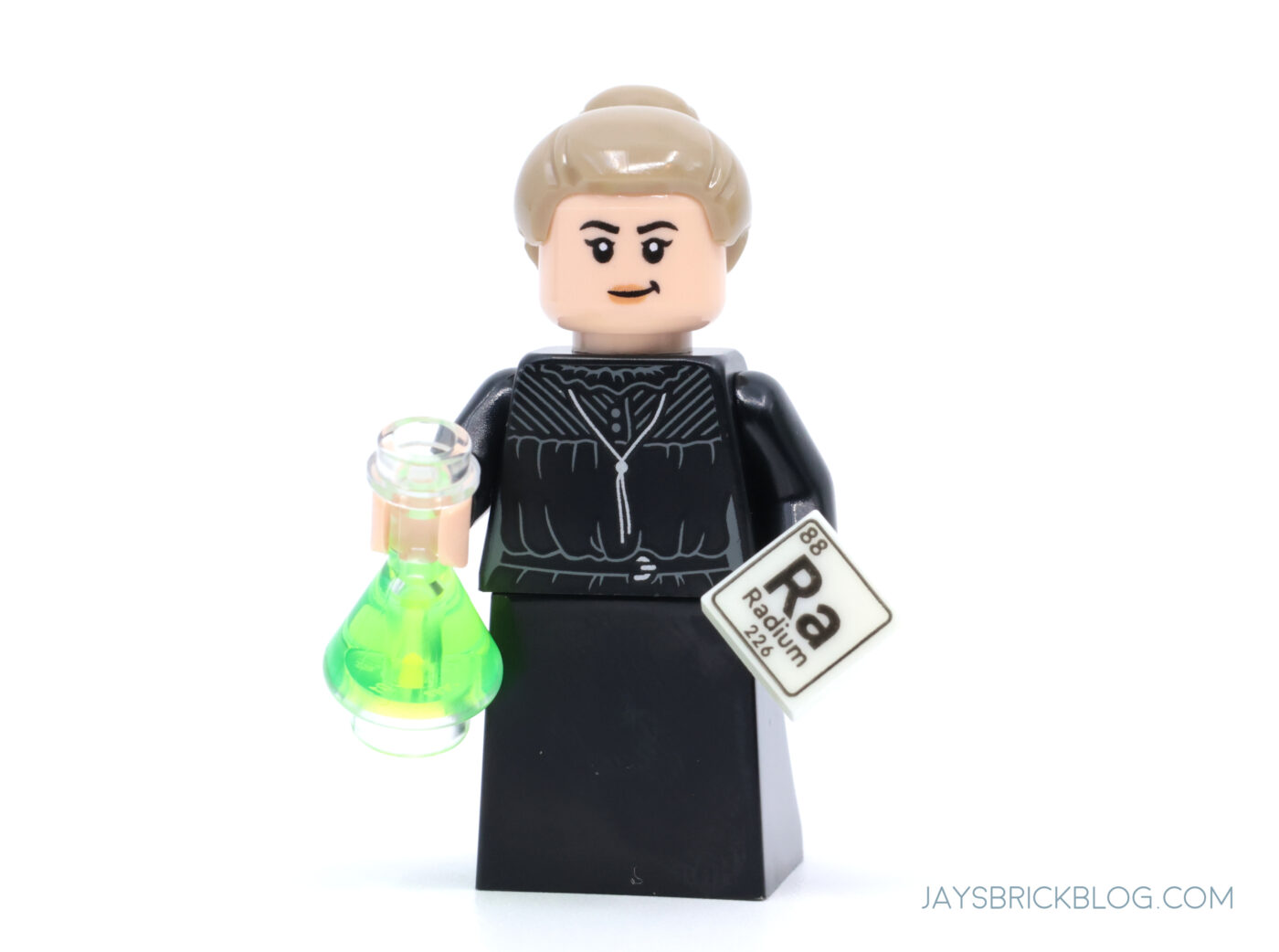
And last but certainly not least, one of the most incredible scientific minds in history, Polish Chemist Marie Skłodowska-Curie. She’s best known for her groundbreaking work in radioactive research, but she has an even more impressive backstory, overcoming sexist environments and challenges where women were not expected to be scientists, to rise up to become the first woman to teach at Sorbonne (University of Paris).
Oh, and in the process, she also won not one but TWO Nobel Prizes, one in Physics which she shared with her husband Pierre Curie, and Henri Becquerel for their study into spontaneous radiation, and later on in Chemistry for her discovery of the elements radium and polonium, the latter of which she named after her native country, Poland.
Her minifigure is fantastic, even though she reuses Pam Beezly’s (from The Office) head, but her period appropriate torso, and hair in a bun depict her perfectly. It’s just a shame her torso print didn’t extend to her dress!

Here’s a look at her alternate face, and her back printing.
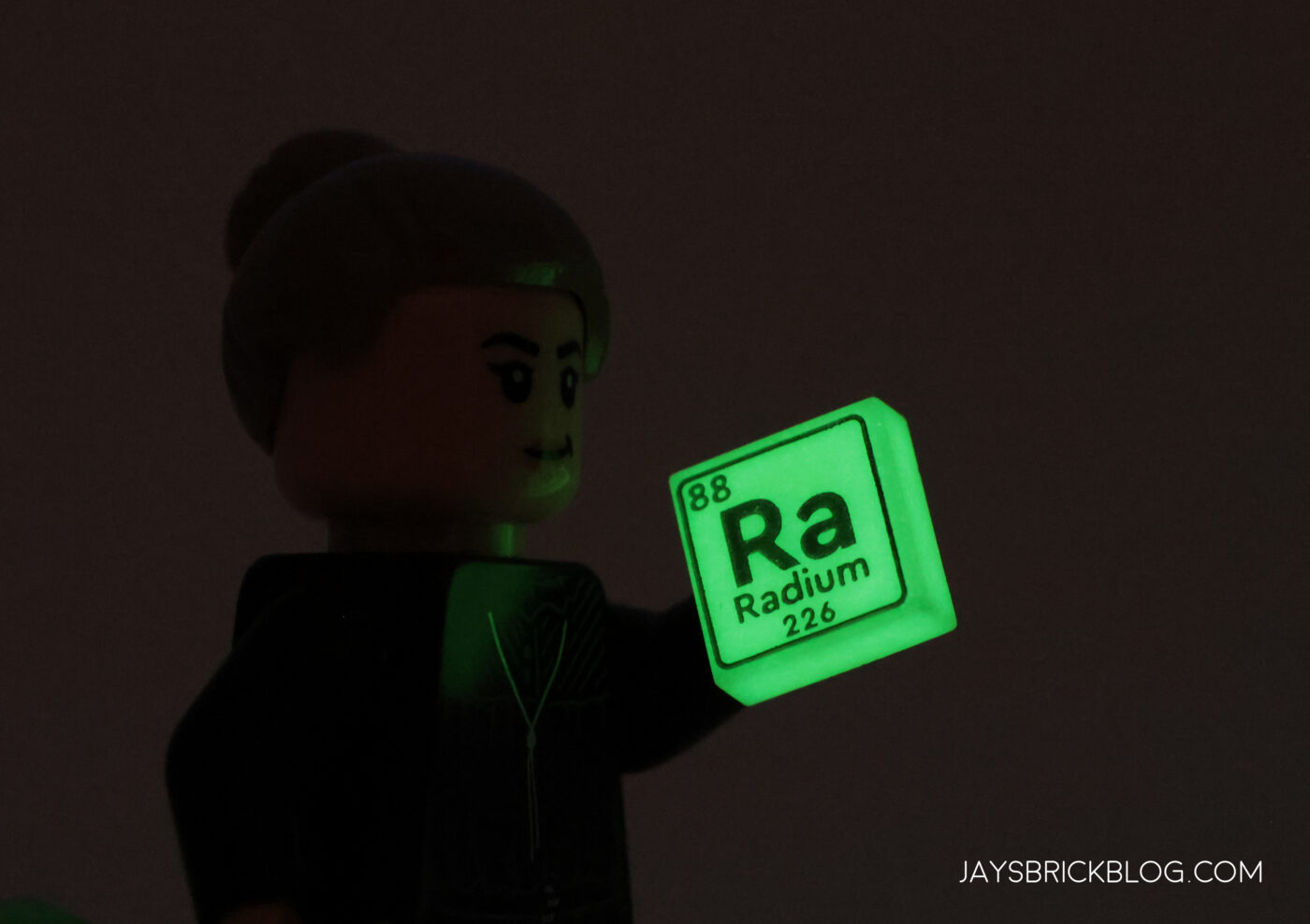
But by far the BEST element in this set has to be the printed Radium tile, which has the Atomic Number 88 and Radium-226 isotope and GLOWS IN THE DARK. It’s the perfect way to showcase radioactivity and such a cool (LEGO) element.

Here’s the completed model, featuring an eruption of STEM-related models from the book.
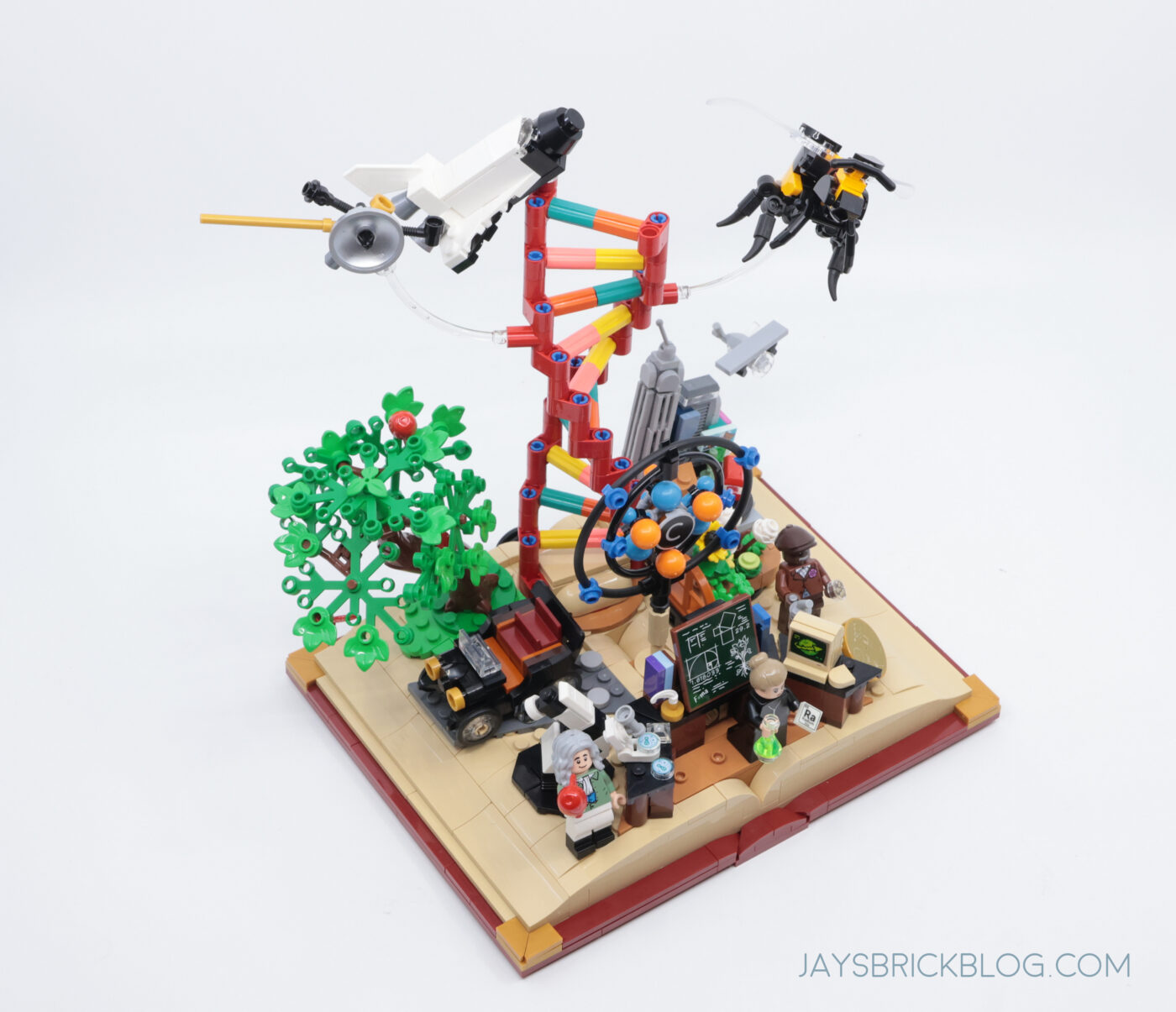
It’s quite a dense model, and there’s a lot going on but I kinda like how visually messy it looks, and I appreciate just how much designer Ollie Gregory managed to cram into the set, while still maintaining an aesthetically-pleasing composition.
Let’s check out some of the builds.
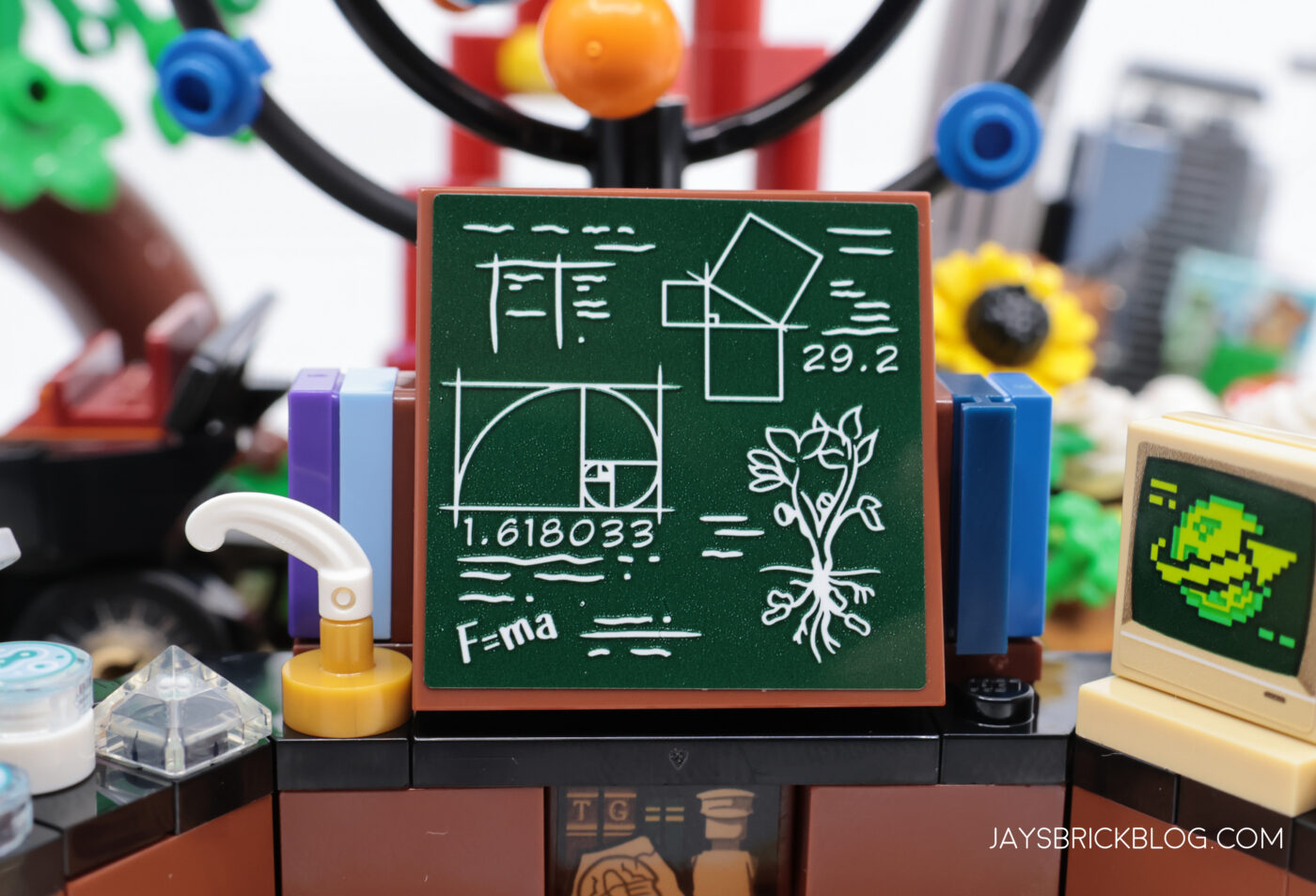
Right in the front is a blackboard with some really cool references. There’s a peanut plant for George Washington Carver’s contribution to American agriculture, a diagram of the Golden Ratio, along with the approximation of 1.618033.
There’s technically an error here, as the golden ratio is 1.6180339, which should be rounded up to 1.618034, but it won’t be the last glaring scientific error in the model. There’s also Newton’s law of motion represented by F=ma, the formula for calculating Force, which equals an object’s mass x acceleration, and even the Pythagorean theorem, a cornerstone of math where A² + B² = C².
I do wish they had snuck in a 3.14 or Pi (π) symbol somewhere here. Can you believe that a set dedicated to STEM doesn’t have one of the best known and most beloved number?? There’s also an Easter Egg here, with the date 29 February. It’s not just a nod to a Leap Year where February has 29 days, but a nod to the fan designer’s anniversary with his partner where they got together on a Leap Year!
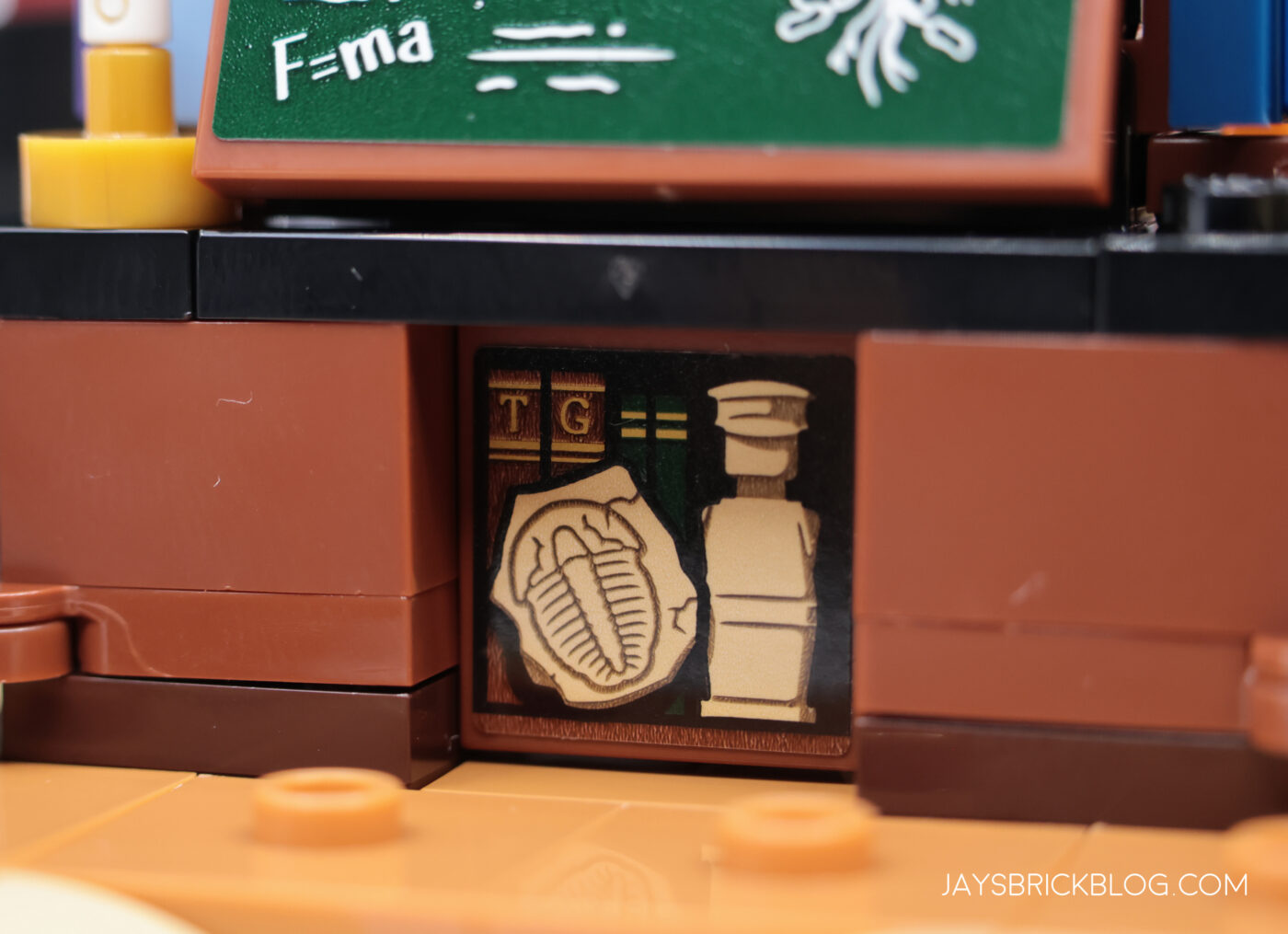
Beneath the black board is a fossilised trilobite, and a nod to the precursor of the LEGO Minifigure – the armless LEGO Police figure! The initials TG are also a nod to the fan designer’s brother.
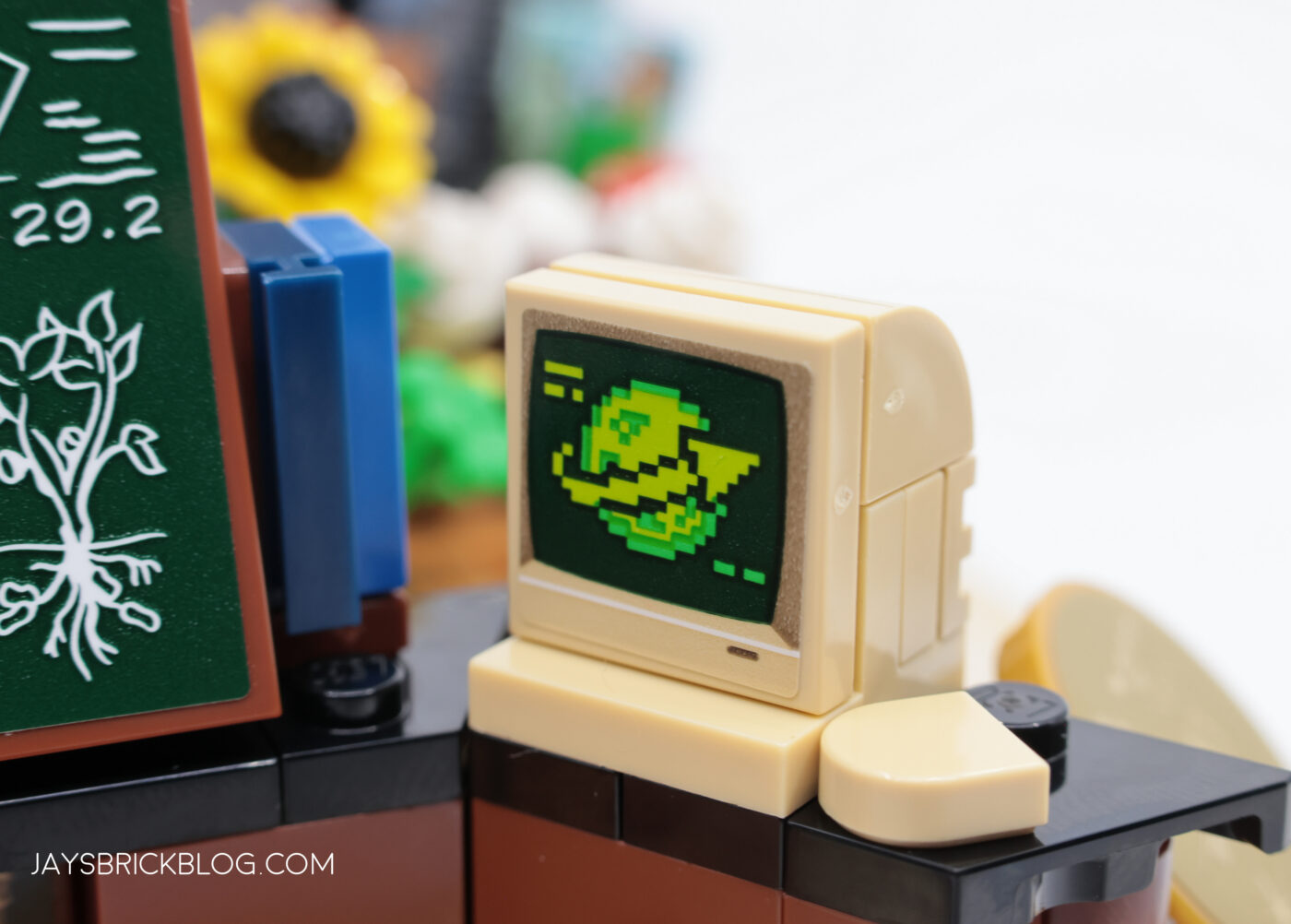
Next to the black board is this very retro looking desktop computer – I appreciate the use of tan instead of white, which really matches early computers, as well as the subtle Classic Space moon nod that I believe is a paper airplane zooming around a planet – email, perhaps? The bane of 21st century worklife and communication.
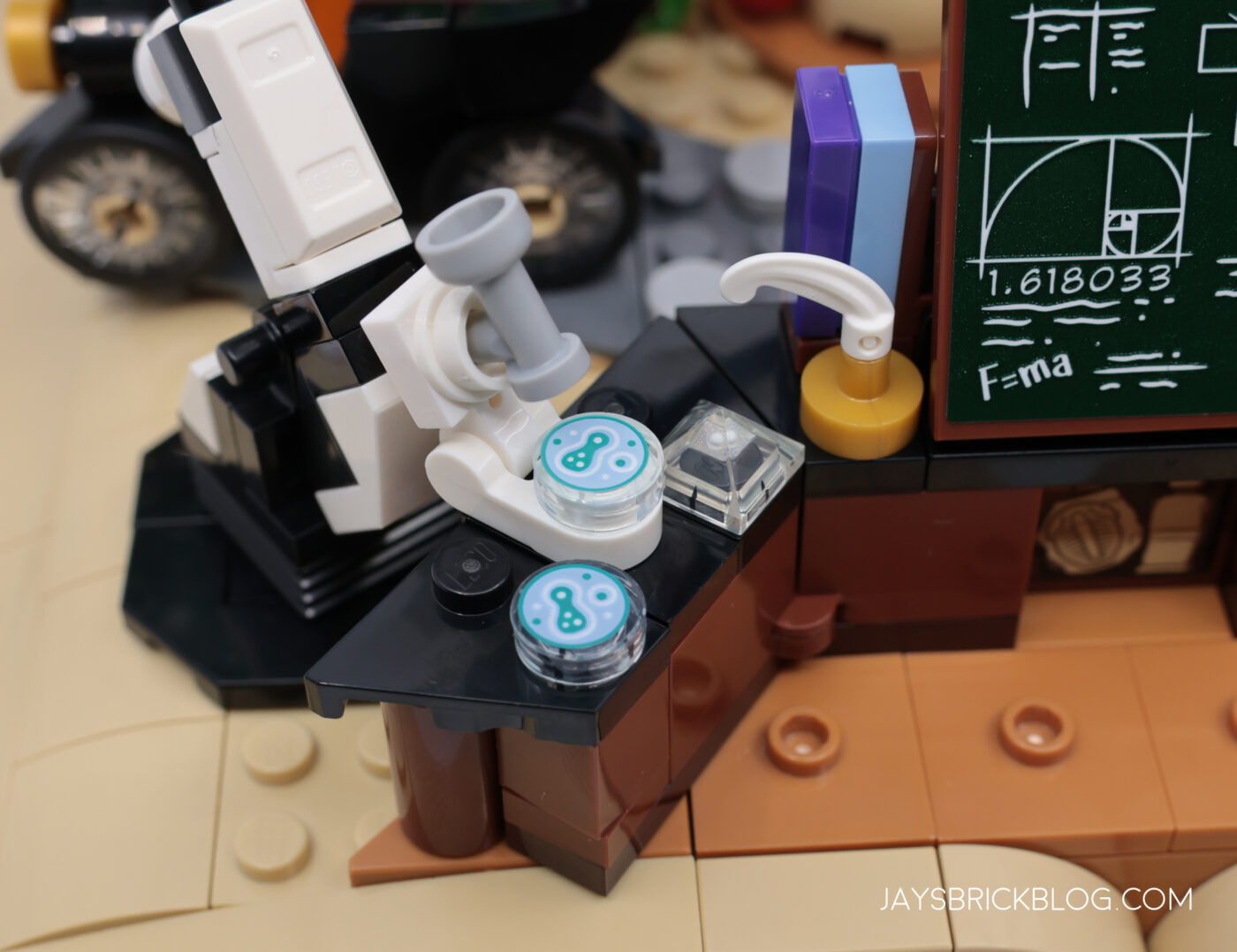
On the other side of the desk, we have a microscope with some microbes, a glass prism that’s a nod to Isaac Newton’s discovery of the colour spectrum, and a quill and books.
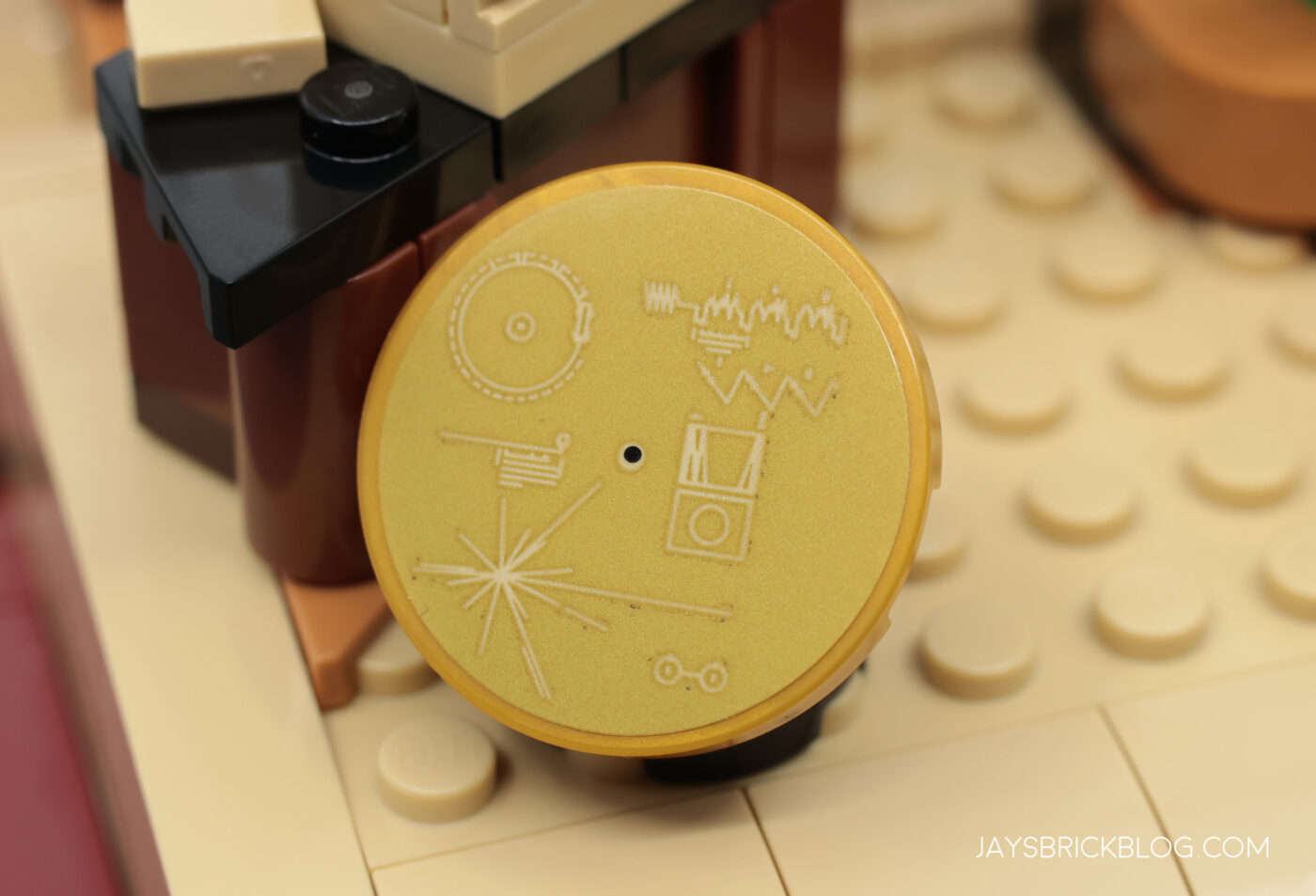
And on the edge of the table is Voyager’s Golden Record, a phonograph record that’s currently flying into deep space on the Voyager spacecraft which contains sounds, and data from Earth, in case extraterrestrial life happens to come into contact with it.
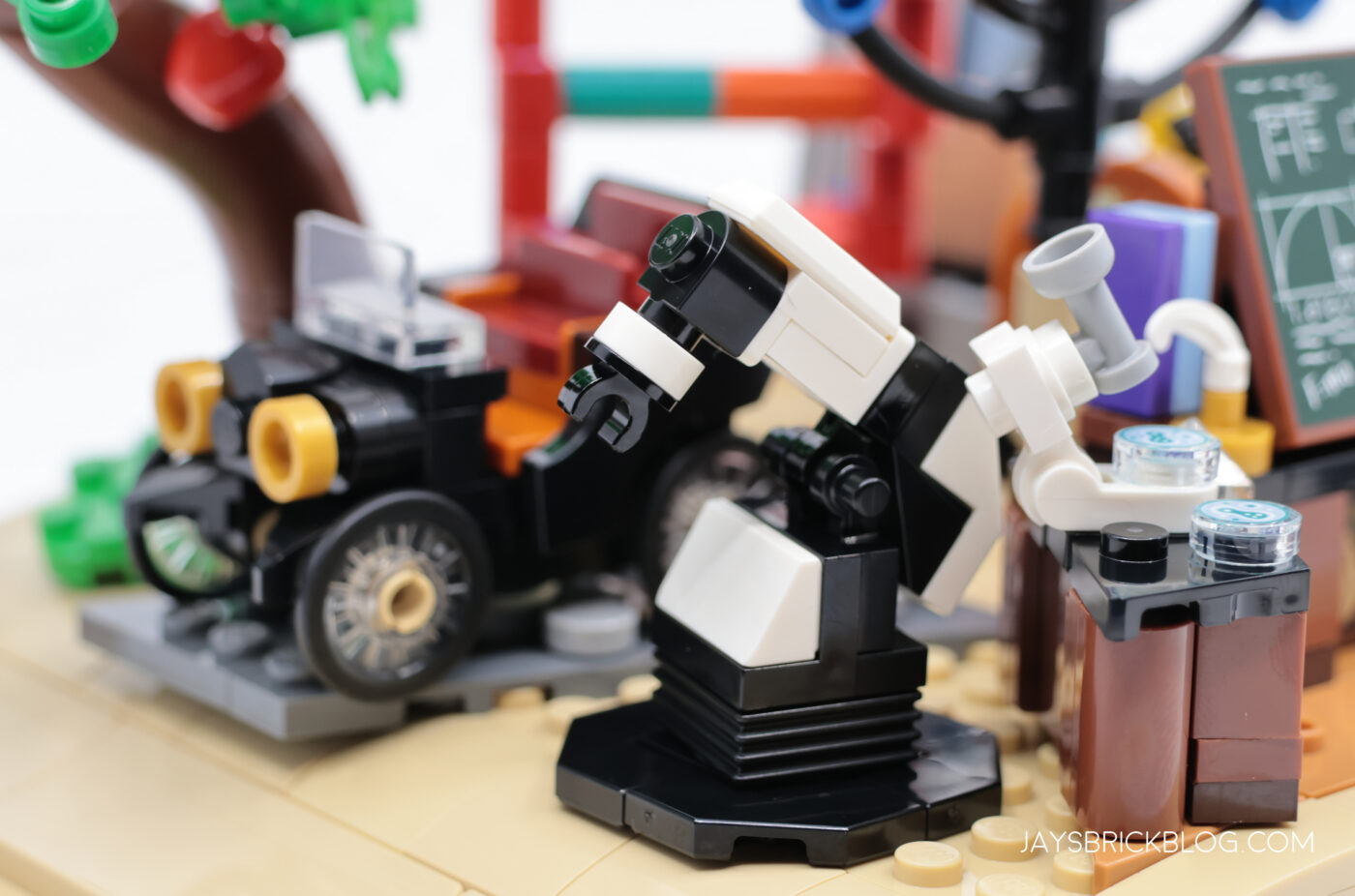
Behind the desk is a robotic arm, a staple of high tech manufacturing.
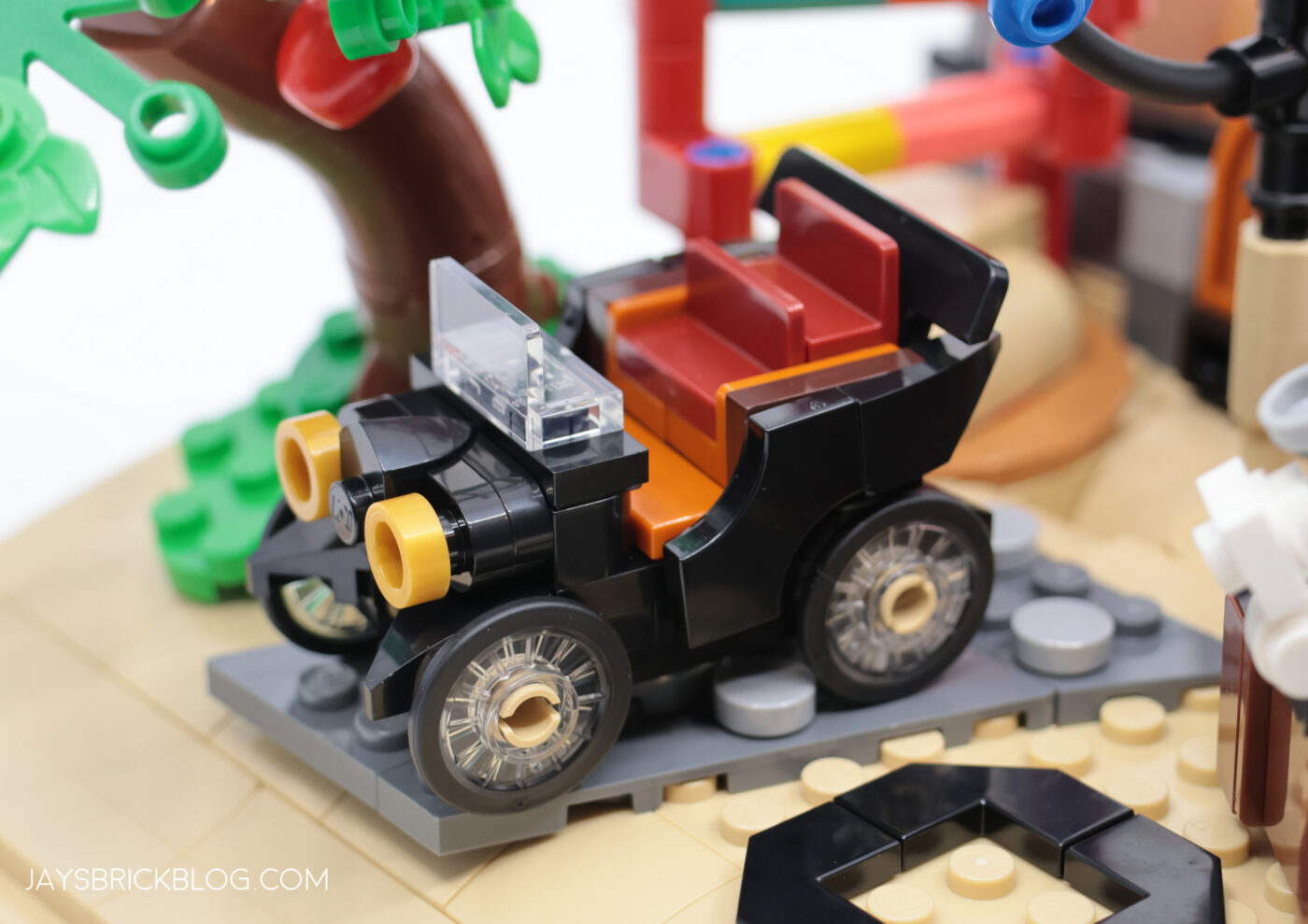
The robotic arm juxtaposes quite nicely with this old timey automobile, an invention that revolutionised transport for mankind. I’d like to think that this design is inspired by the Ford Model T, by Henry Ford, an invention that was the first mass-affordable automobile.
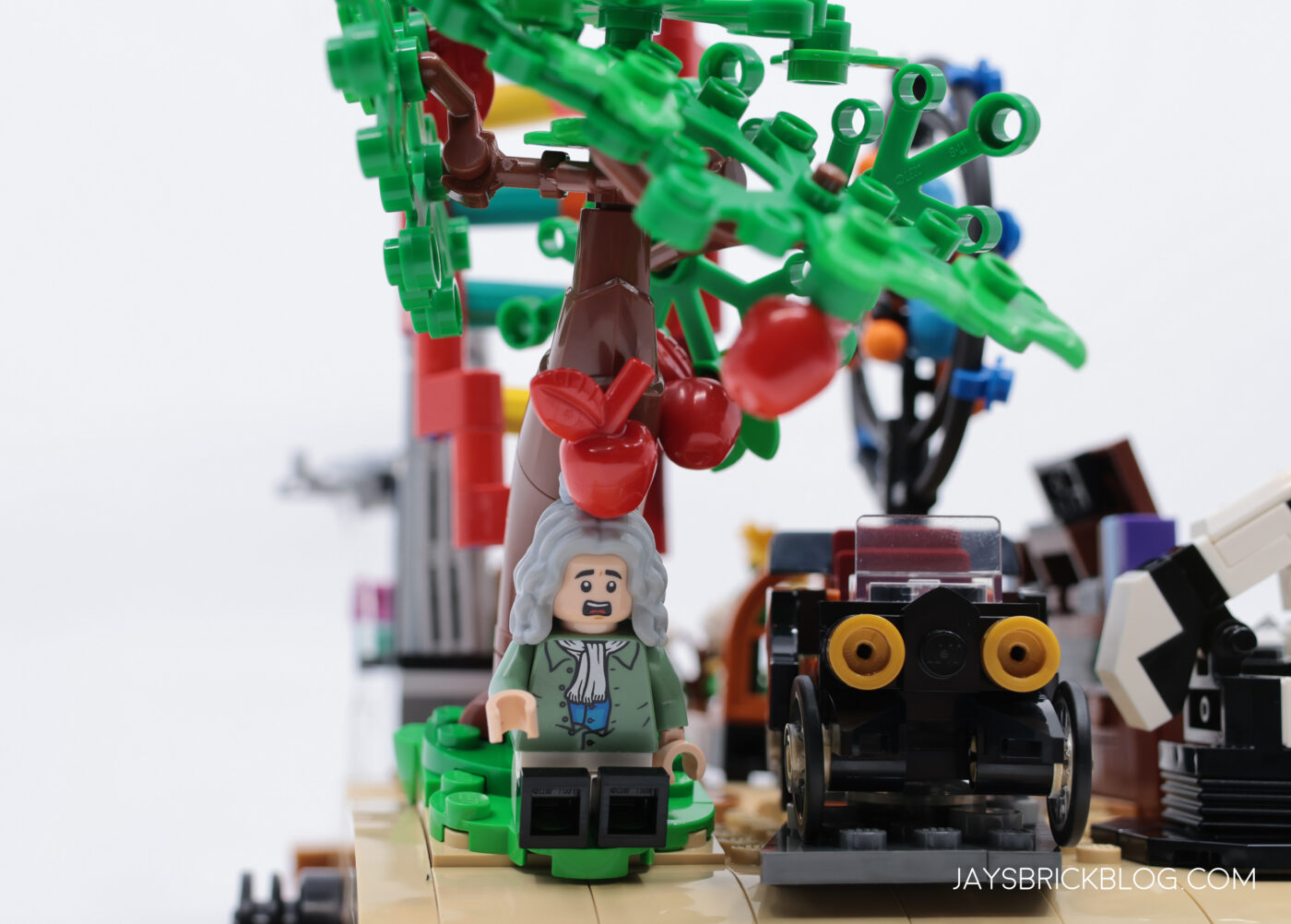
Next to the car is an apple tree, with space for Isaac Newton to sit and ponder the mysteries of the universe on. Just watch out for any falling apples that might spark an epiphany which would forever change the world of physics!
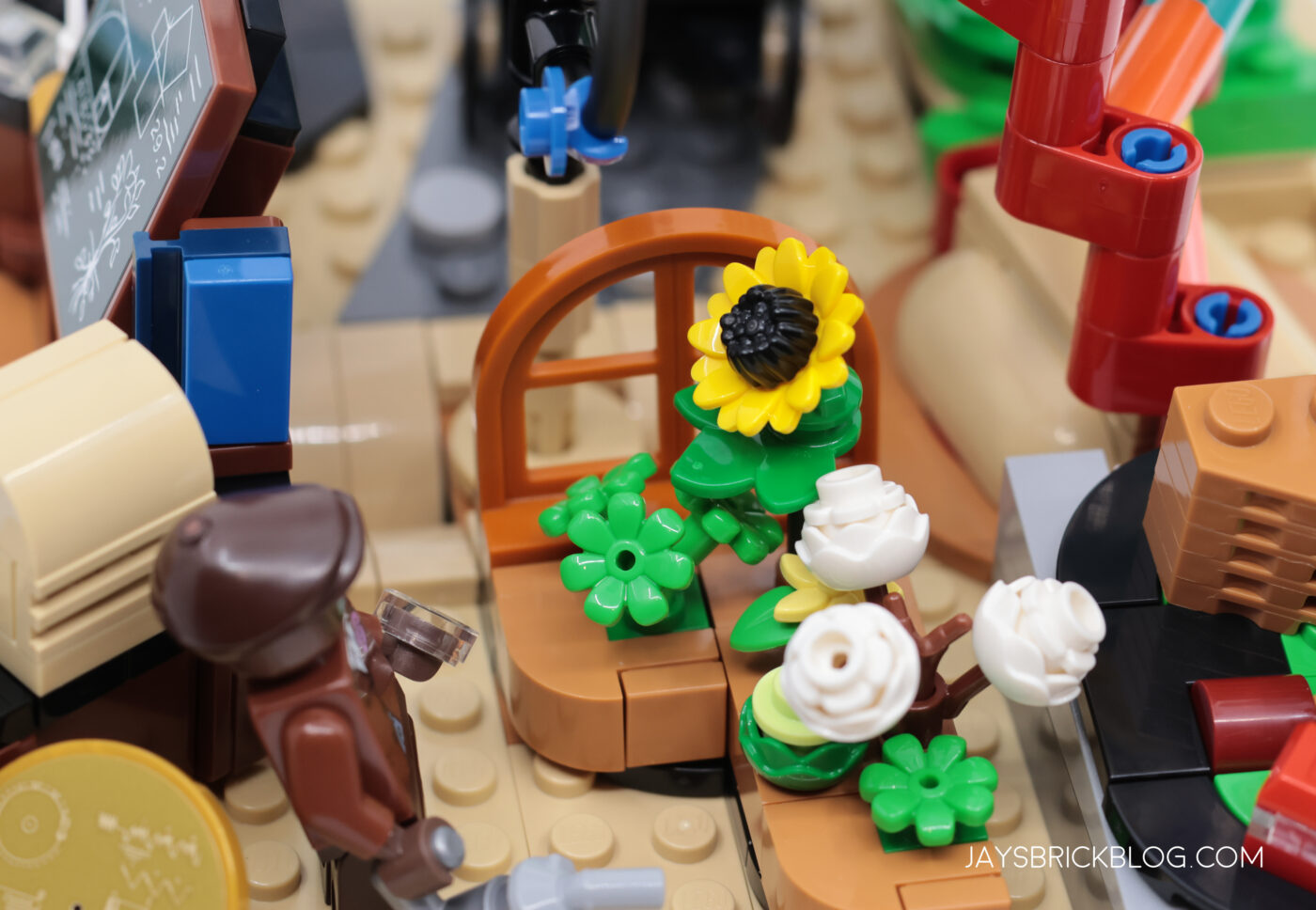
On the other end, we have a small garden with cotton plants, a sunflower and smaller plants. This is a nod to George Washington Carver’s work on encouraging farmers to avoid soil depletion by rotating crops.
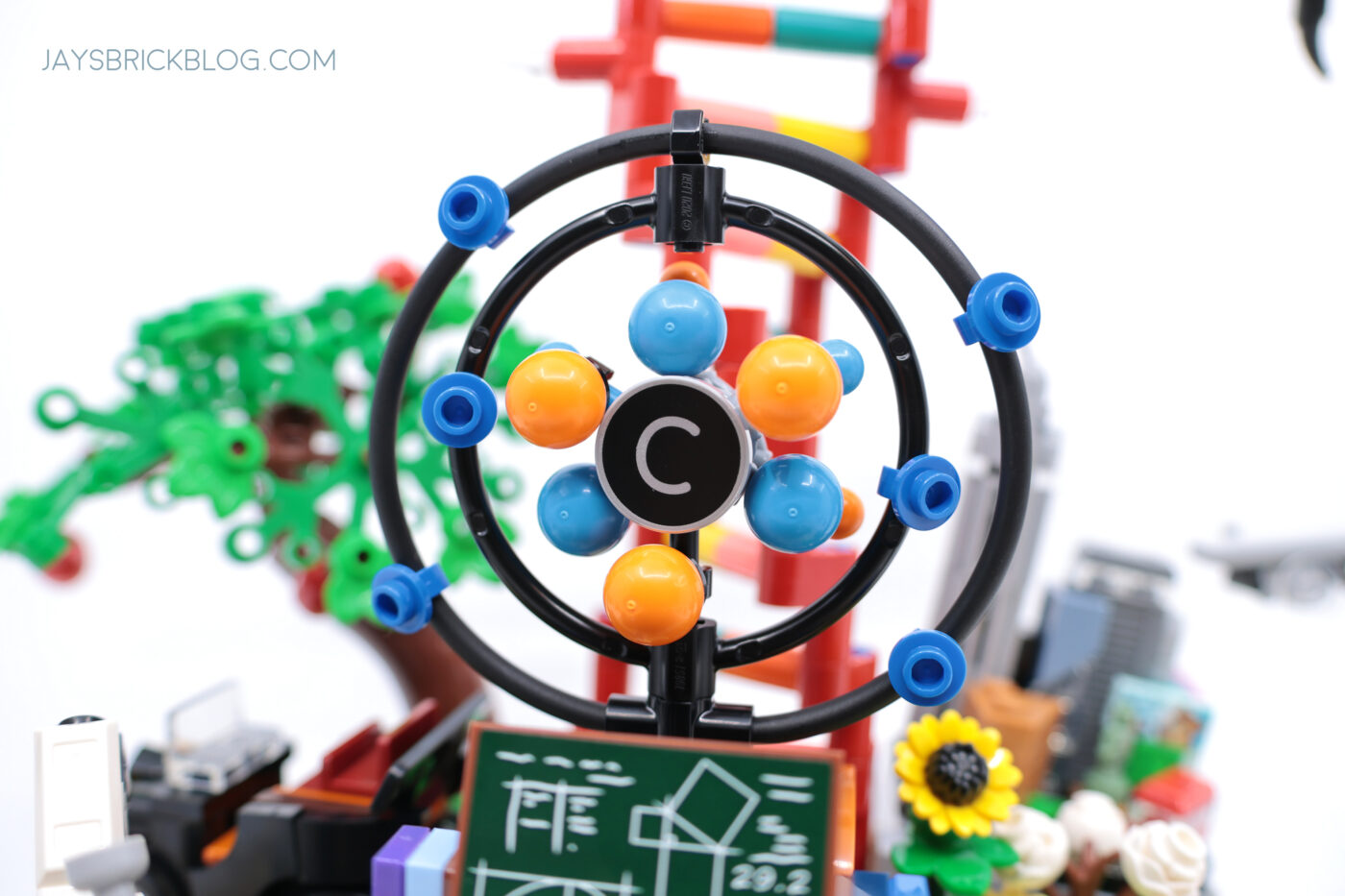
In the middle of the build is a really cool representation of a Carbon atom, the essential building block for organic compounds in our universe. There’s some really clever parts usage here with the C from the LEGO Ideas Typewriter for the nucleus, and blue and orange orbs surrounding it representing 6 protons, 6 neutrons.
On the outer ring are 6 electrons, making up the most common isotope of carbon, which is carbon-12.
The carbon atom also bobs up and down when activating the play feature.
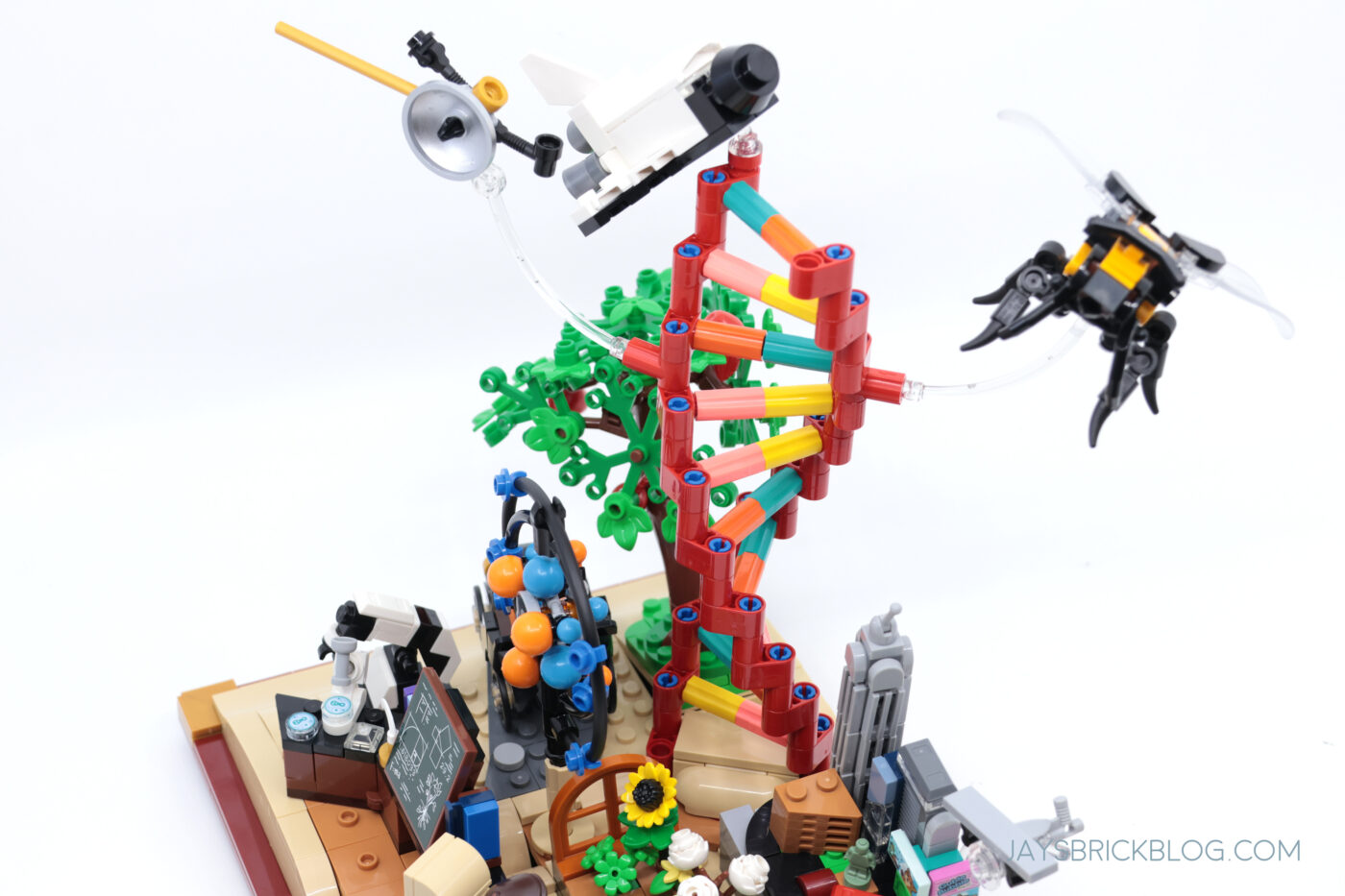
Right behind the Carbon Atom is the tallest structure, a Double Helix to represent DNA, hereditary material that form our genes and is found in the nucleus of every cell. The colourful Technic axles connectors are great ways to relay the base pairs that make up DNA.
The Double Helix structure looks great BUT… there is a critical error with the design here which is frankly, a little embarrassing but par for the course for LEGO’s atrocious lack of attention to detail.
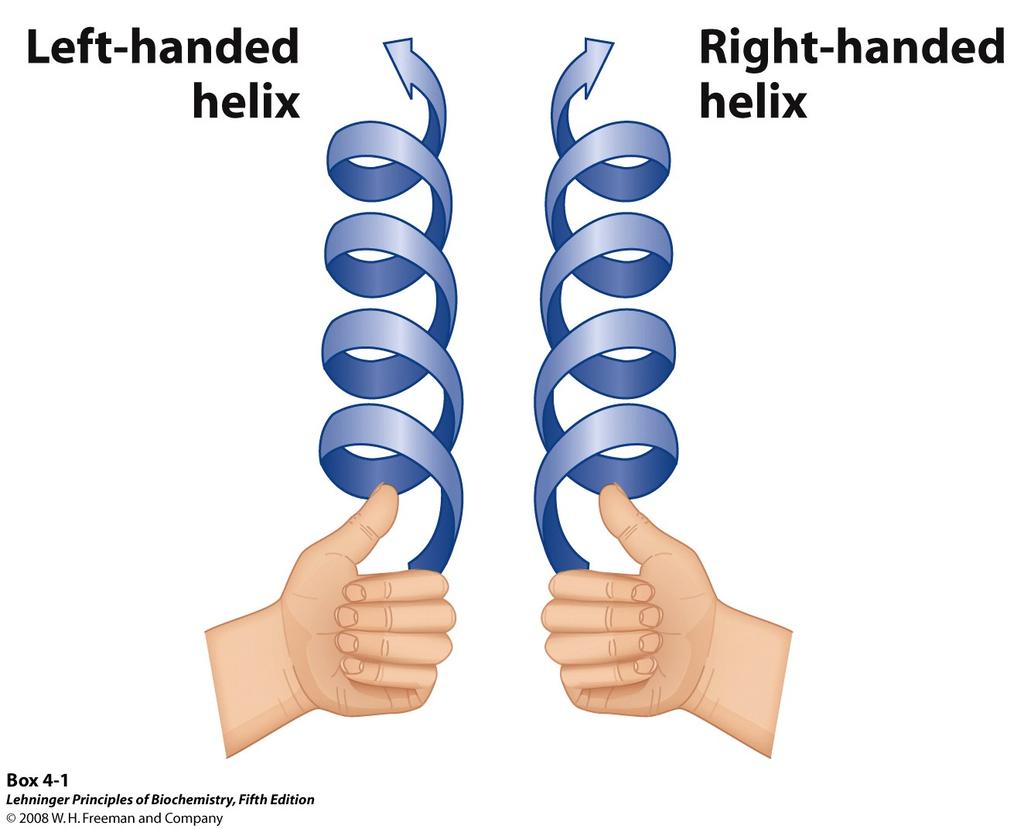
There are 2 types of helix, based on how they rotate and DNA is always a right-handed helix. The one in the set is left-handed, which is a surprisingly common error when DNA is depicted in media.
Of course this is LEGO, and you can easily rectify this by reversing the Double Helix to correct it, but it’s somewhat befuddling for a set with so much emphasis on Science to get something like this so wrong. That said… this could be LEGO making a case for Mirror Life, a controversial subject where scientists have spoken out against the creation of mirror bacteria, constructed from mirror images of molecules found in nature which are in essence, synthetic forms of life.
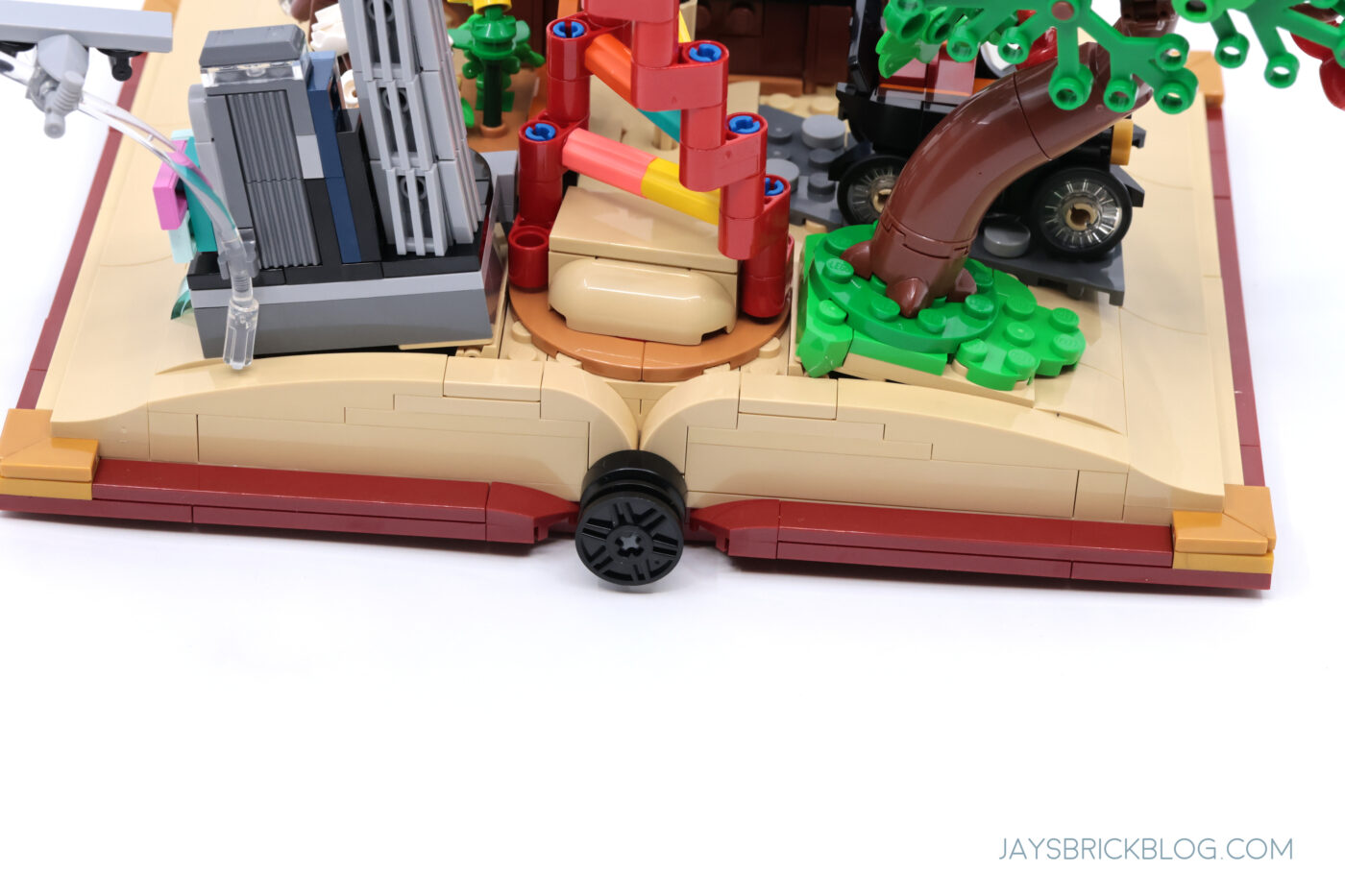
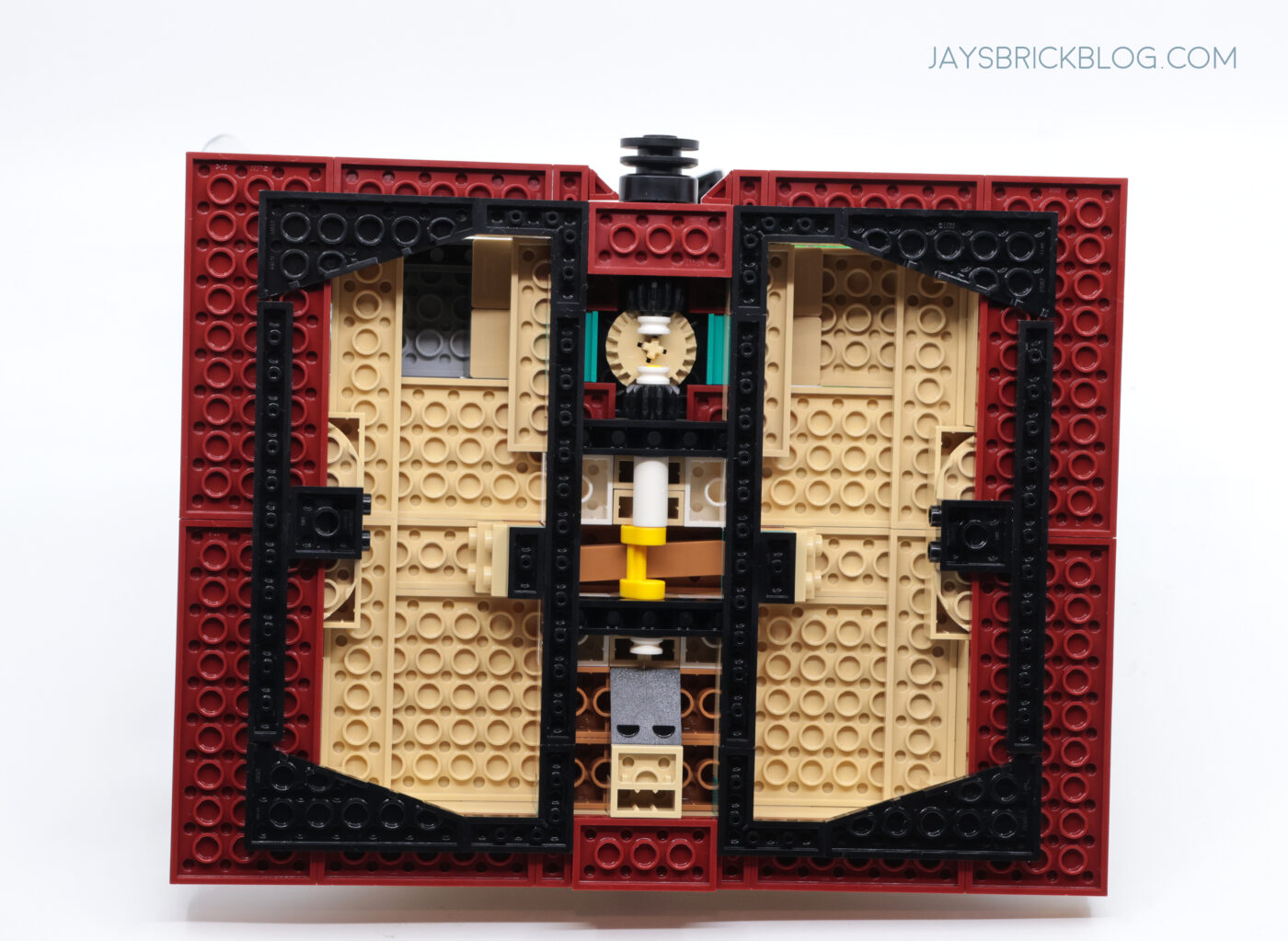
At the back is a small wheel that you can twirl to make the Double Helix rotate and Carbon Atom bob up and down which is pretty cool way to introduce some motion and interactivity with the set. For best results, hook up some Power Functions or a Technic Hub to make it rotate on its own.

To represent the advancement of humanity from living in caves, to huts, to villages, to towns, settlements and ultimately cities, there’s a small microscale city here with some fun nods to metropolitan cities, and even the fan designer’s UK heritage with a London Bus.

As a special treat to the fan designer, a new printed element is included for the billboard in this microscale city! The cat is a nod to Daniel Bradley’s own cat Zeus. This is his favourite Easter Egg in the entire build. What an incredible to have your cat immortalised in LEGO like this!
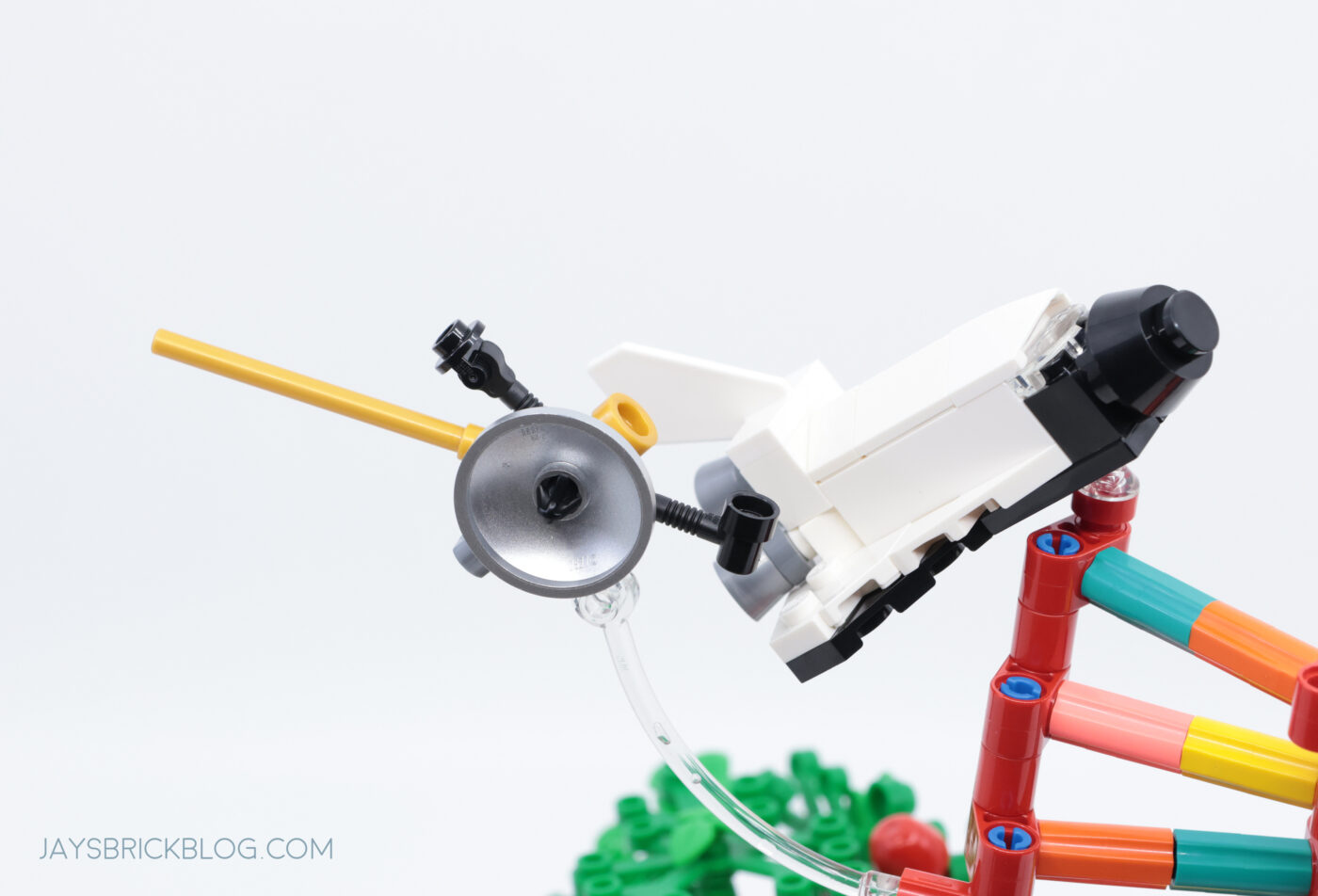
Attached to the double helix is a small build representing the Voyager Program, space probes that set off from earth in 1977 and are currently hurtling through interstellar space, and as of the time of writing this, about 15.4 billion miles away from Earth! Next to it is a space shuttle. Did you know you can monitor Voyager’s progress on this super cool NASA webpage?

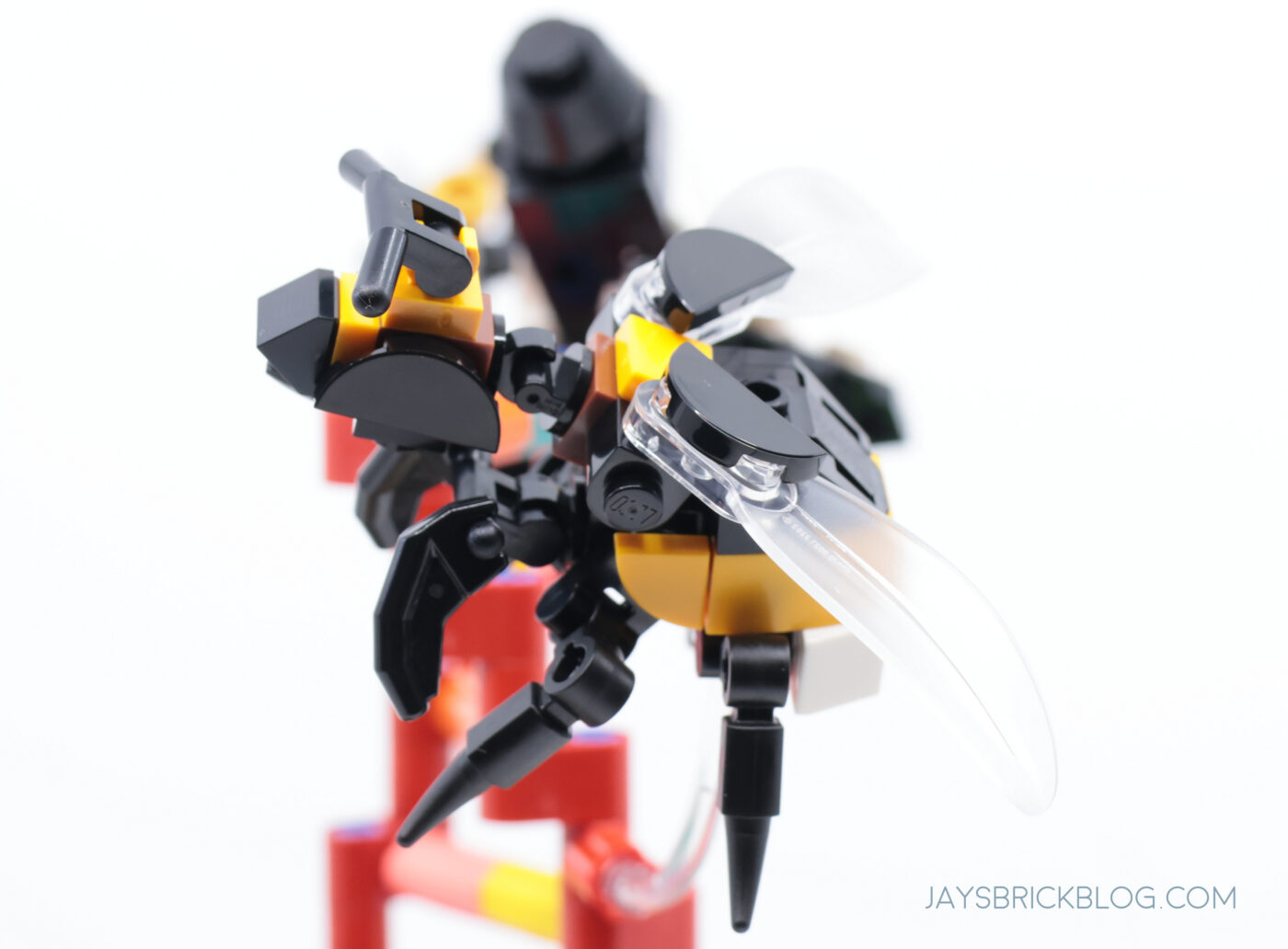
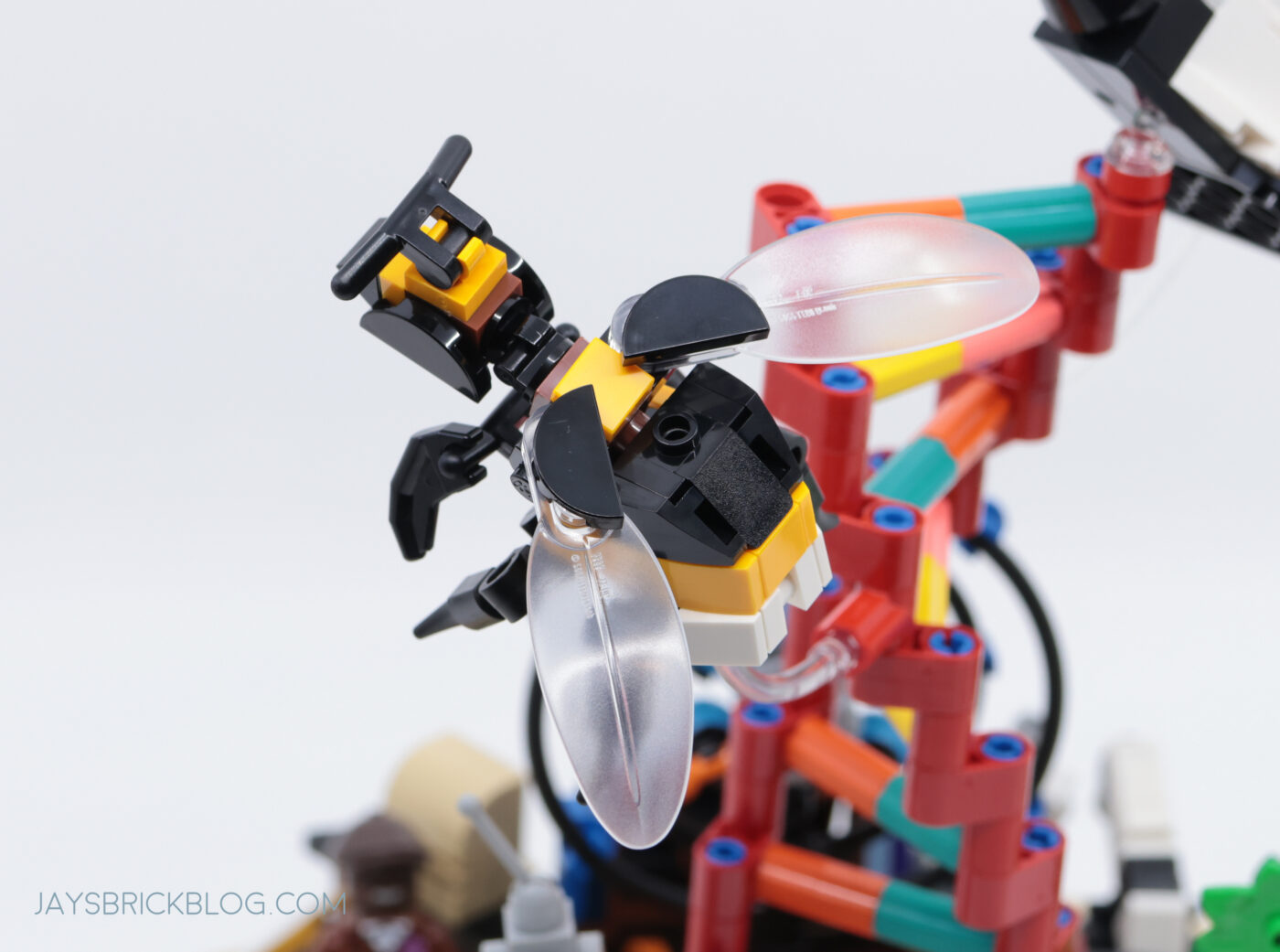
And last but not least, the final build that you finish with the set is this bumblebee. The humble bumblebee is of course integral to pollination and the growth and reproduction of flowering plant species. Without bees, we’d all be doomed!
The build is a little fiddly, but features some really novel construction techniques and parts usage to make it look quite realistic. I do also love the new trans-clear leaf elements which are used for its wings!

What I liked:
- Incredible historical minifigures, especially Marie Skłodowska-Curie
- Fun new elements and recolours to discover
- Plenty of fun Science-y Easter Eggs
- Great all-around model that celebrates STEM
What I didn’t like:
- Embarrassing errors like the reversed Double Helix
- Open book design is a little stale
- No Pi reference
Final Thoughts
I really enjoyed 21355 The Evolution of STEM and the spotlight it shines of scientific achievement and discovery. Modern day LEGO seems to be dominated by pop culture licenses, and the latest shiny movie or thing, so to get a grounded set like this which is rooted in history, scientific discovery and mankind’s ingenuity is a breath of fresh air against the dozens of Star Wars and video game sets that are now LEGO’s bread and butter.
In many ways, this also feels like a classic LEGO Ideas set that pays homage to the theme’s earliest sets like 21100 Shinkai 6500 Submarine, 21101 Hayabusa, and 21110 Research Institute which were all rooted in Science.
As an educational tool, this set is priceless and those with younger kids who may have an interest in STEM will definitely appreciate the learning opportunity that a set like this creates. It’s a fun and interactive way to introduce Marie Skłodowska-Curie, George Washington Carver and Sir Isaac Newton, and a myriad of other scientific inventions and achievements to bright young minds.
As a set, the model is fairly well-designed, with an aesthetically-pleasing (if a little busy!) composition, but the different micro models provide fun variety through the build and make for interesting visual treats. I wouldn’t call it a beautiful set, but it still successfully condenses many different scientific achievements and hidden Easter Eggs into a fun toy.
As a younger boy, I was fascinated by all things STEM, and although I didn’t really have the opportunity (or let’s be honest, aptitude/discipline) to pursue a career or education in STEM, this set did take me back to a nostalgic time when it seemed like there were new and exciting discoveries emerging every day, where the future seemed so bright and optimistic.
Now as a man, I am in a place where I can still be appreciative, curious and feel a sense of wonder about the evolution of science, and thanks to the accessibility of educational content on the internet and LEGO sets like 21355 The Evolution of STEM, it’s never a bad opportunity to stop, pause and be reminded of the many different scientists, pioneers and discoveries that brought us to this day.
Final Score
Audience rating
21355 The Evolution of STEM will be released on 1 March 2025, and will be available from LEGO.com or your local LEGO Store.
What do you think of the LEGO Ideas Evolution of STEM set?
To get the latest LEGO news and LEGO Reviews straight in your inbox, subscribe via email, or you can also follow on Google News, or socials on Facebook, Instagram (@jayong28), Bluesky or subscribe to the Jay’s Brick Blog Youtube channel.


